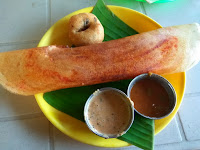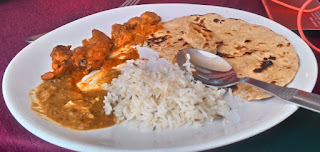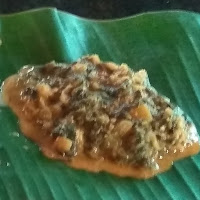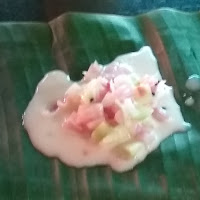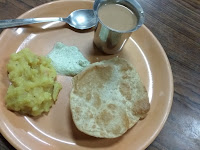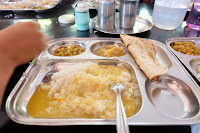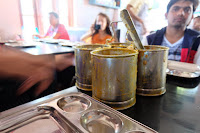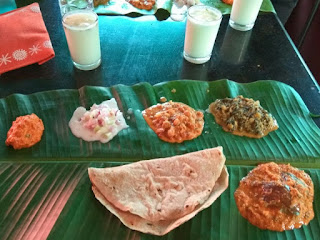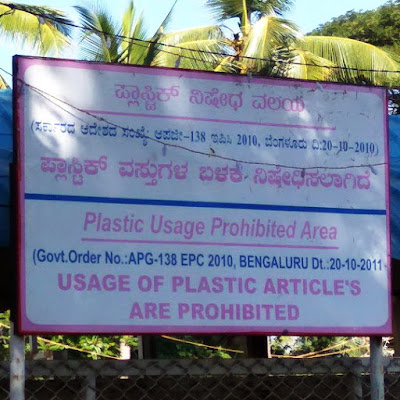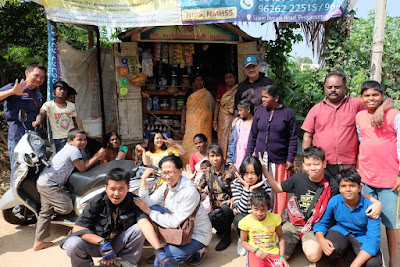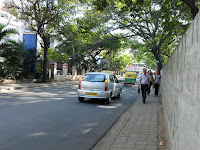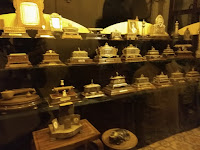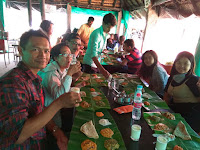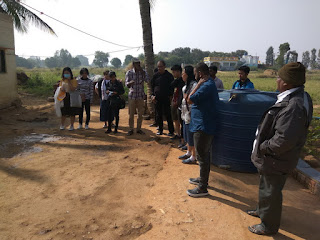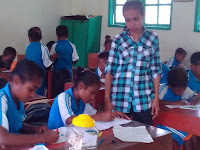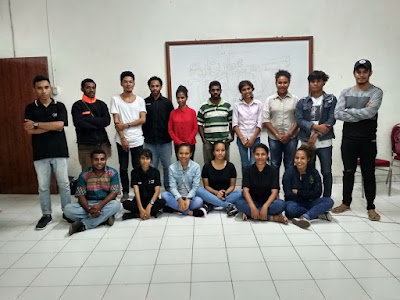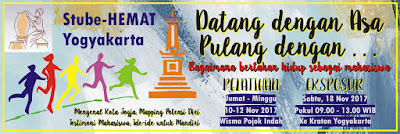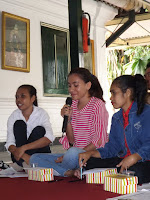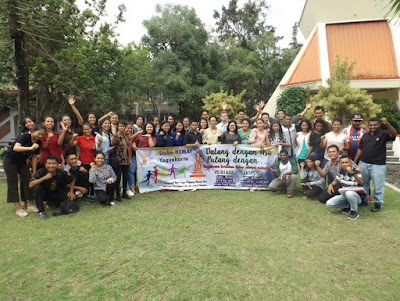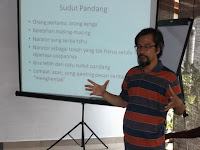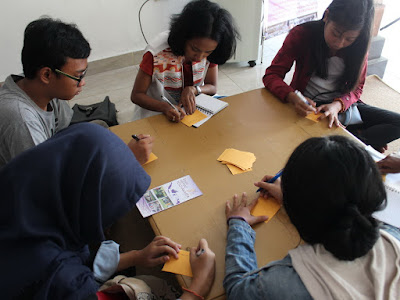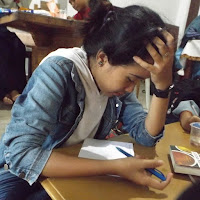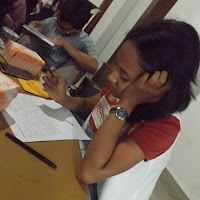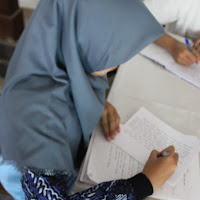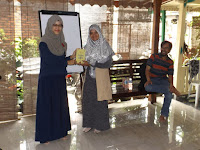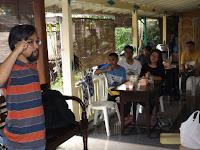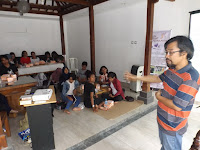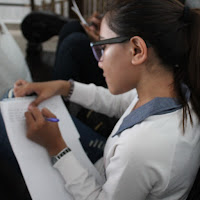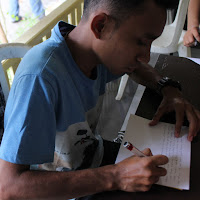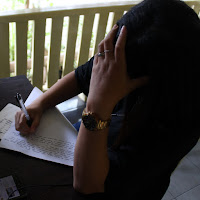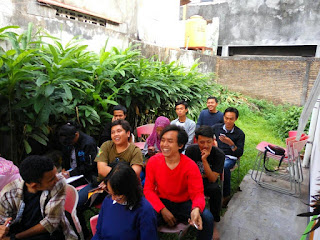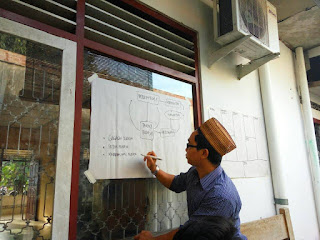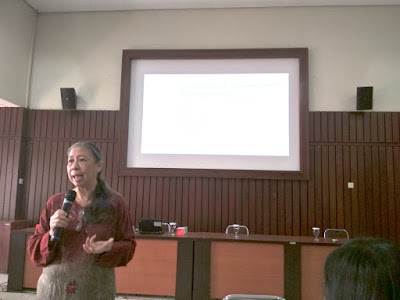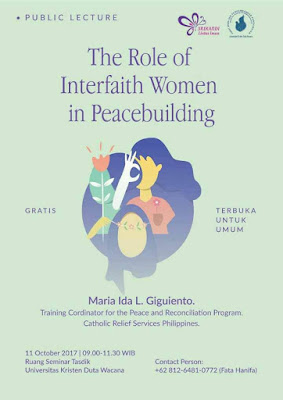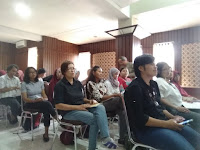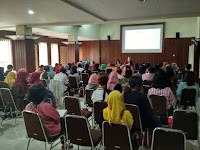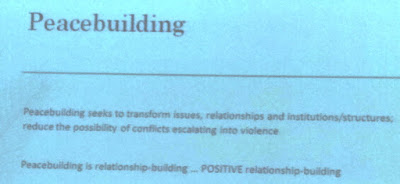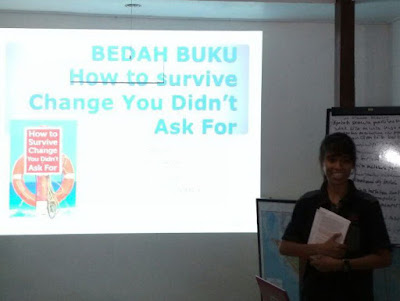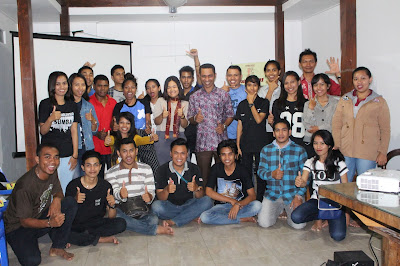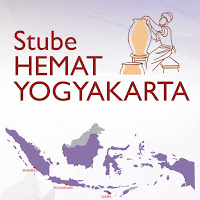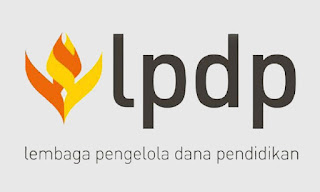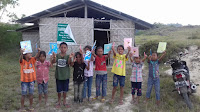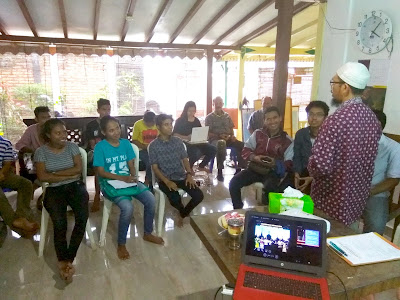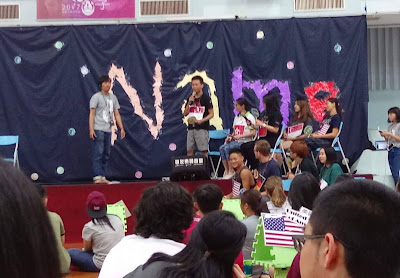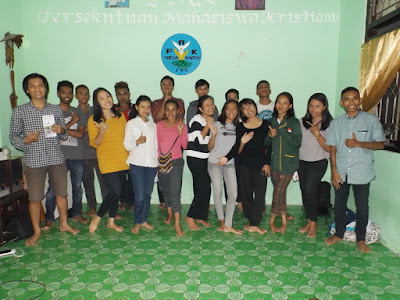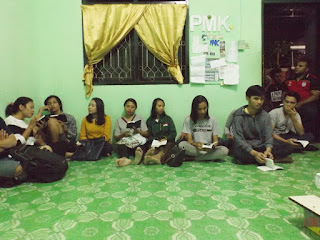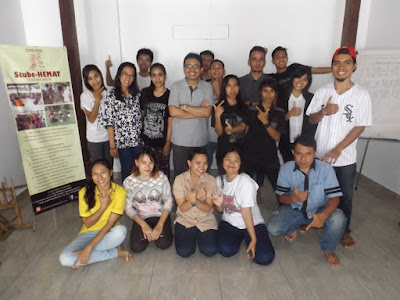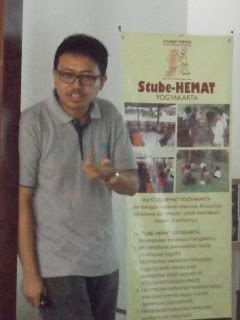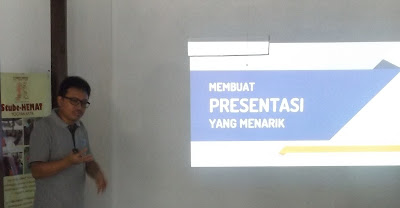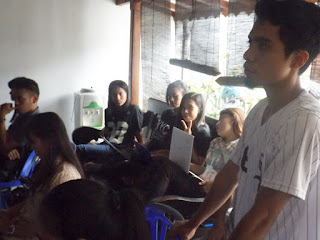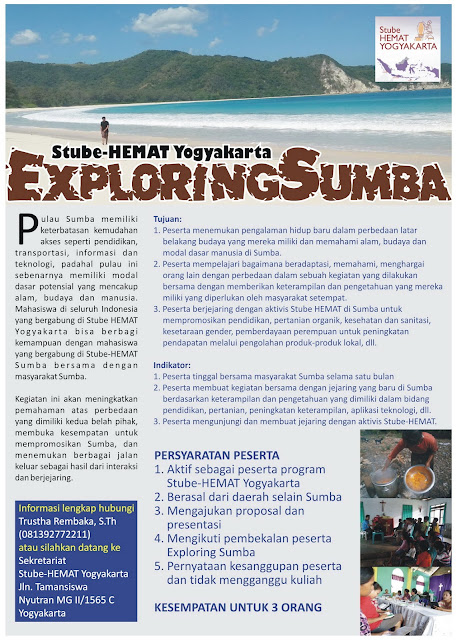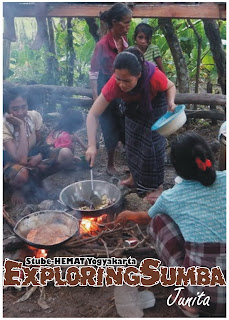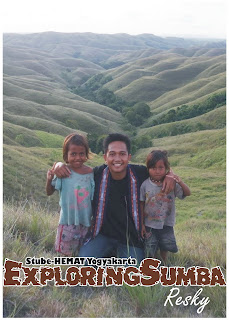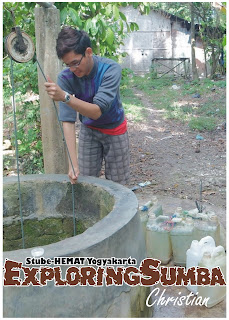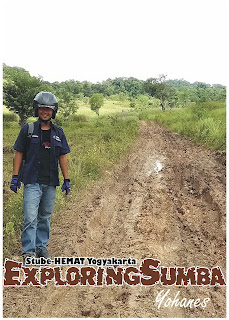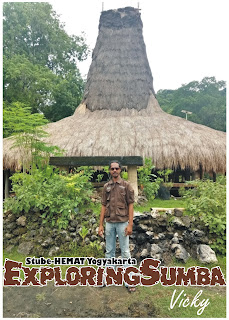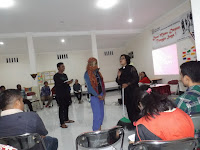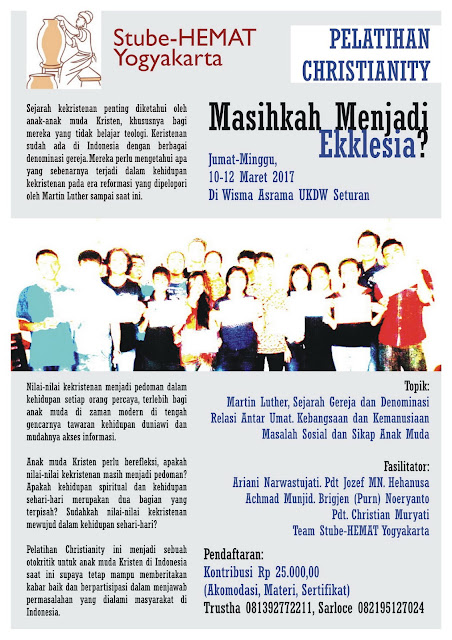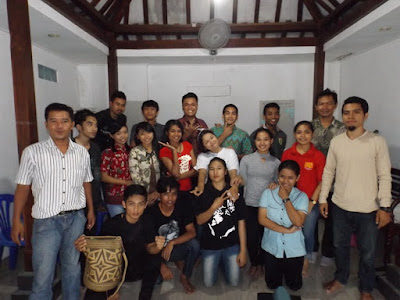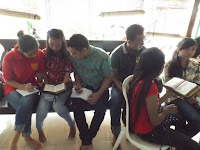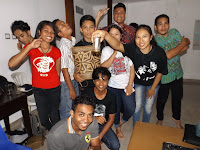Indian Youth and Social Problems
Friday, 29 December 2017by adminstube
Towards One Indian Official Language
Friday, 29 December 2017by adminstube
Healthy Menu Ala India Bangalore - Mysore - Ooty - Hosur
Friday, 29 December 2017by adminstube
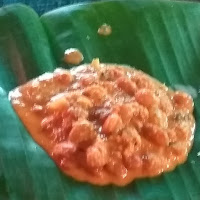 The protein source is obtained from vegetables and beans processed with coconut milk or spices. Some dishes from beans are a kind of soybeans, lentils and long beans. In addition, there are cassava leaves processed into dishes like‘rendang’ in Indonesia. As a refresher, milk yoghurt plus cucumbers, tomatoes and onions are processed into pickles. It becomes a refreshing dish during having eating, but not all people like it.
The protein source is obtained from vegetables and beans processed with coconut milk or spices. Some dishes from beans are a kind of soybeans, lentils and long beans. In addition, there are cassava leaves processed into dishes like‘rendang’ in Indonesia. As a refresher, milk yoghurt plus cucumbers, tomatoes and onions are processed into pickles. It becomes a refreshing dish during having eating, but not all people like it.Tracing Back the Ancestors of Sumbanese in India
Friday, 29 December 2017by adminstube
The Challenge of Cleanliness and Waste Management India – Indonesia
Friday, 29 December 2017by adminstube
Dalit Theology: The Form of Love to Others (South to South Exchange Program to SCM India)
Friday, 29 December 2017by adminstube
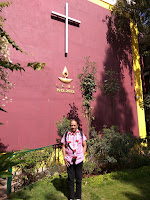 The results and fruit of Dalit Theology are perceived by Indian indemocracy, the increase of rightequality, the success of lower class in education and became agents of change to lead to more developed society. One real evidence of Dalit Theology is SCMI.
The results and fruit of Dalit Theology are perceived by Indian indemocracy, the increase of rightequality, the success of lower class in education and became agents of change to lead to more developed society. One real evidence of Dalit Theology is SCMI.
Scooping Inspiration in India (South to South Exchange Program to India)
Friday, 29 December 2017by adminstube
 South-to-South Exchange Program to India fully supported by Ecumenical Scholarship Program Brot-für-die-Welt, Germany, on 19-27 December 2017 was held to support the reasons mentionedabove, particularly facilitating youth of the two countries to meet each other. Eight participants from Indonesia are Bambang Sumbodo, Ariani Narwastujati, Trustha Rembaka, Yohanes Dian Alpasa, Indah Theresia, Elisabeth Uru Ndaya, Jimmy Nover Putu and Anggita Getza Permata. They attended discussions and did exposures with Student Christian Movement in India (SCMI).
South-to-South Exchange Program to India fully supported by Ecumenical Scholarship Program Brot-für-die-Welt, Germany, on 19-27 December 2017 was held to support the reasons mentionedabove, particularly facilitating youth of the two countries to meet each other. Eight participants from Indonesia are Bambang Sumbodo, Ariani Narwastujati, Trustha Rembaka, Yohanes Dian Alpasa, Indah Theresia, Elisabeth Uru Ndaya, Jimmy Nover Putu and Anggita Getza Permata. They attended discussions and did exposures with Student Christian Movement in India (SCMI).
 This city became the starting point of all activities that began with welcoming, introducing each other and a session delivered by Rev. Godson, a pastor of Methodist Church in India, who researched the benefits of palm trees/lontar (B. Flabellifer). This tree is known as tuak, lontar or siwalan crops in Indonesia. During students dialogue, Stube-HEMAT presented the activities and dynamics of Christian youth service in Indonesia. Furthermore, SCMI India activists described SCMI as the oldest ecumenical youth organization in India because it was formed since 1912 and experienced in serving young people in India based on the love of Christfor every human being. SCMI activity covered thirteen regions of India started from local unit level in campus, church and city, region and national level.
This city became the starting point of all activities that began with welcoming, introducing each other and a session delivered by Rev. Godson, a pastor of Methodist Church in India, who researched the benefits of palm trees/lontar (B. Flabellifer). This tree is known as tuak, lontar or siwalan crops in Indonesia. During students dialogue, Stube-HEMAT presented the activities and dynamics of Christian youth service in Indonesia. Furthermore, SCMI India activists described SCMI as the oldest ecumenical youth organization in India because it was formed since 1912 and experienced in serving young people in India based on the love of Christfor every human being. SCMI activity covered thirteen regions of India started from local unit level in campus, church and city, region and national level.
Finally, Amba Vilasa palace, the magnificent palace of Sultan of Tippu with its gigantic pillars, carved doors and paintings on the palace ceiling welcomed thousands of tourists who were stunned by the beauty of the buildings and heritages.
 The city is located in the highlands of Tamil Nadu state, southern India. The bus trip from Bangalore to Ooty was usually 7 hourshowever it became 12 hours, due to traffic jams. The journey traversed straight and winding road through towns, villages, fields and Bandipur and Mudumalai national parks.
The city is located in the highlands of Tamil Nadu state, southern India. The bus trip from Bangalore to Ooty was usually 7 hourshowever it became 12 hours, due to traffic jams. The journey traversed straight and winding road through towns, villages, fields and Bandipur and Mudumalai national parks.Ooty located more than 300 km south of Bangalore became a tourist destination because it has interesting places like tea plantation, lakes, chocolate making and eucalyptus distillation. The large number of visitors with four-wheeled vehicles on the narrow and winding roads with cliffs on the left and ravines on the right passing through tea plantations caused total congestion. This area needed to be rearranged for its road management and area’s carrying capacity.
Dedicating Knowledge Enlightening Society
Saturday, 16 December 2017by adminstube
 Stube-HEMAT Yogyakarta, as a student mentoring institution from various regions studying in Yogyakarta gave students an opportunity to think about their abandoned home areas through Local Exposure programin which they may map potencies and challenges of theirregions, open networks in his/her region and applytheir knowledge. Three students joined as participants in 2017, this year. Who were they?
Stube-HEMAT Yogyakarta, as a student mentoring institution from various regions studying in Yogyakarta gave students an opportunity to think about their abandoned home areas through Local Exposure programin which they may map potencies and challenges of theirregions, open networks in his/her region and applytheir knowledge. Three students joined as participants in 2017, this year. Who were they?
 Finally he changed the target to young people in his village and students of SMK (vocational school) Marhaen. There were two dozens young people and students enthusiasticallyattended basic computer training, how to operate computer and type letters. They were divided into several groups andErik adjusted the time they have, because some ofthem have to study and work. Currently one trainee have practiced their skills as typists at schools.
Finally he changed the target to young people in his village and students of SMK (vocational school) Marhaen. There were two dozens young people and students enthusiasticallyattended basic computer training, how to operate computer and type letters. They were divided into several groups andErik adjusted the time they have, because some ofthem have to study and work. Currently one trainee have practiced their skills as typists at schools.
 A student of Governmental Science at STPMD APMD Yogyakarta, is from Saureinu, South Sipora, Mentawai Islands, West Sumatera. She has an attention on the environment problem in her village because the local residents are still littering rubbish anywhere even in rivers. The residents living near a river frequently complain about the dirty river so they cannot bathe in it. The cattle pen usually built in front of their houses also needed to be rearranged, so she thought that she should give enlightenment to them to care about the environment and health.
A student of Governmental Science at STPMD APMD Yogyakarta, is from Saureinu, South Sipora, Mentawai Islands, West Sumatera. She has an attention on the environment problem in her village because the local residents are still littering rubbish anywhere even in rivers. The residents living near a river frequently complain about the dirty river so they cannot bathe in it. The cattle pen usually built in front of their houses also needed to be rearranged, so she thought that she should give enlightenment to them to care about the environment and health.
 When she interacted with the people, she faced difficulty to invite them to participate in socializationsession aboutenvironmental sanitation. It was caused by people’s low awareness about it, even worse that some local students who should have more advanced thinking were un-aware of it. Nevertheless the head of Saureinu village supported her activities by providing opportunity for presentation. Further, they will invite people to work together and participate in creating Saureinu village environment cleaner in the future.
When she interacted with the people, she faced difficulty to invite them to participate in socializationsession aboutenvironmental sanitation. It was caused by people’s low awareness about it, even worse that some local students who should have more advanced thinking were un-aware of it. Nevertheless the head of Saureinu village supported her activities by providing opportunity for presentation. Further, they will invite people to work together and participate in creating Saureinu village environment cleaner in the future.
 A young girl from Gardakau, Benjina, Aru Islands, Maluku. Her village consists of islands so the education facilities are not well distributed, even the island in where she lives has only elementary school level, so the students have to bounce across the sea to continue to junior high school. This prompted Tasya, a student of Indonesian Language and Literature Education at Sarjanawiyata Tamansiswa University in Yogyakarta to take benefit from her campus break byaccompanying school children in her village to study, by walking around the village through mangroves and coastal area to learn something,telling story and rewriting what they hear and read book.
A young girl from Gardakau, Benjina, Aru Islands, Maluku. Her village consists of islands so the education facilities are not well distributed, even the island in where she lives has only elementary school level, so the students have to bounce across the sea to continue to junior high school. This prompted Tasya, a student of Indonesian Language and Literature Education at Sarjanawiyata Tamansiswa University in Yogyakarta to take benefit from her campus break byaccompanying school children in her village to study, by walking around the village through mangroves and coastal area to learn something,telling story and rewriting what they hear and read book.
 The children enthusiastically took part the activities because Tasya practiced new approaches, praised them, provided experiential learning to nature and gave expression space through writing and drawing. The parents felt so happy because their children were eager to learn and discover new experiences about the lessons and environment around them.
The children enthusiastically took part the activities because Tasya practiced new approaches, praised them, provided experiential learning to nature and gave expression space through writing and drawing. The parents felt so happy because their children were eager to learn and discover new experiences about the lessons and environment around them.
2 Hours closer with Friends of UJB
Thursday, 30 November 2017by adminstube
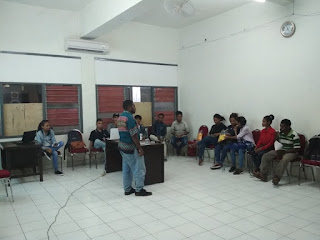 Honestly, there were severalreasons why theyfollowed the training, such as,they did not havefriends at the boarding house and they were pushed to join the program bytheir friends, like Estrela, Maria and Talia. However, there is alsoanother reason why they must follow this training asthey needed to follow it, like Hanis and Fangges. At the end of the training they admitted how they understood and got new knowledge about business and important things related with the new village regulation delivered in the last session of the training. Finally, after following the plot of training, they began to understand why they werethere. Now, Hanis has had a network already withRumah Kreatif Jogja for trading a typical bag from Maybrat Papua in Jogja and knitted bag from Jogja to Maybrat, Papua.
Honestly, there were severalreasons why theyfollowed the training, such as,they did not havefriends at the boarding house and they were pushed to join the program bytheir friends, like Estrela, Maria and Talia. However, there is alsoanother reason why they must follow this training asthey needed to follow it, like Hanis and Fangges. At the end of the training they admitted how they understood and got new knowledge about business and important things related with the new village regulation delivered in the last session of the training. Finally, after following the plot of training, they began to understand why they werethere. Now, Hanis has had a network already withRumah Kreatif Jogja for trading a typical bag from Maybrat Papua in Jogja and knitted bag from Jogja to Maybrat, Papua.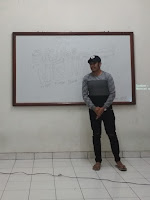
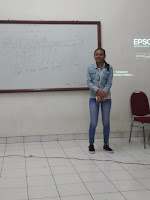 Considering the importance of material, they made a small discussion with some student of Janabadra Universityfacilitated byStudent ActivityCentre of Christian Community and some other students about business and how to survive as a student. On Friday, 17th November 2017 at Janabadra University of Yogyakarta, there were seventeen students interested in joining their follow-upactivity. The discussion was opened by Elisabeth whointroduced what Stube-HEMAT is and then Hanis, Fangges, Maria, Estrela and Talia telling about material from the training. Estrela said, “Honestly, first I felt pushed to make a question in a session, but then I thought that it was important for me to think and give opinion when I follow discussion because I am a passive one. Stube taught me to find some ideas and shared it with others. Mariaadmitted, “I learned many interesting things and I knew more another side of Jogja related withcriminal case and it made me to be more careful”.
Considering the importance of material, they made a small discussion with some student of Janabadra Universityfacilitated byStudent ActivityCentre of Christian Community and some other students about business and how to survive as a student. On Friday, 17th November 2017 at Janabadra University of Yogyakarta, there were seventeen students interested in joining their follow-upactivity. The discussion was opened by Elisabeth whointroduced what Stube-HEMAT is and then Hanis, Fangges, Maria, Estrela and Talia telling about material from the training. Estrela said, “Honestly, first I felt pushed to make a question in a session, but then I thought that it was important for me to think and give opinion when I follow discussion because I am a passive one. Stube taught me to find some ideas and shared it with others. Mariaadmitted, “I learned many interesting things and I knew more another side of Jogja related withcriminal case and it made me to be more careful”. Elisabeth added that to be a good mediator can’t be instant because there is a process that must befollowed. The last training, Stube made a follow up how to be a good mediator. Besidestheory, the participants were also trained to make a mediation practice based on the theoretical process.
Elisabeth added that to be a good mediator can’t be instant because there is a process that must befollowed. The last training, Stube made a follow up how to be a good mediator. Besidestheory, the participants were also trained to make a mediation practice based on the theoretical process.Obtaining the Life Meaning from Yogyakarta Palace
Monday, 20 November 2017by adminstube
The initiation process of the construction of the center of Ngayogyakarta was started with ‘God’s revelation’ through Prince Mangkubumi’s dream about a holy and clean place between Mount Merapi and Parangkusumo beach, located between several rivers, namely Winongo, Bedog and Progo on the west and Code, Gajahwong and Opak on the east. When the place was found, it was a jungle called Beringan, with a small village called Pacetokan. October 9, 1755 was the beginning to open the forest and build kingdom center. The construction was completed on October 7, 1756 and began to be occupied by the royal family. The date is set as the anniversary of Yogyakarta.
To Yogyakarta with dreams and come back home with ...
Tuesday, 14 November 2017by adminstube
Pursuing ideas and write!
Monday, 6 November 2017by adminstube
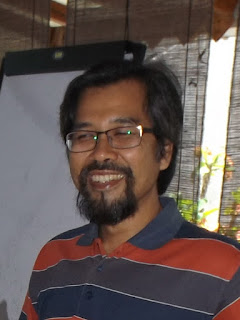 "Writing fiction is like digging a well with a needle. It is not easy anda hard work. He should have idea or inspiration, but he cannot just wait for the idea or inspiration but should seek and pursue ideas", said Achmad Munjid starting the Workshop on Writing Fiction, on Sunday, November 5, 2017 at Stube-HEMAT Yogyakarta secretariat. This was a collaboration between Stube-HEMAT Yogyakarta and team of Magister of Literature Science of Gadjah Mada University as a dedication program to community.
"Writing fiction is like digging a well with a needle. It is not easy anda hard work. He should have idea or inspiration, but he cannot just wait for the idea or inspiration but should seek and pursue ideas", said Achmad Munjid starting the Workshop on Writing Fiction, on Sunday, November 5, 2017 at Stube-HEMAT Yogyakarta secretariat. This was a collaboration between Stube-HEMAT Yogyakarta and team of Magister of Literature Science of Gadjah Mada University as a dedication program to community.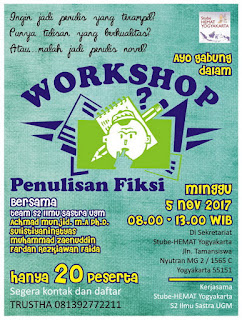 Twenty students from various campuses and regions studying in Yogyakarta and local youth as staffs of child-friendly village team attended a workshop facilitated by Achmad Munjid, M.A. Ph.D., a lecturer at Faculty of Cultural Sciences UGM, along with him wereSulistyaningtyas, Muhammad Zaenuddin and Fardan Rezkiawan Faida. Three of them were students of Magister in Literature of UGM. The facilitator felt so glad to meet participants of Stube-HEMAT Yogyakarta and appreciated Stube’s fast response to prepare the activity well although in short time and students' enthusiasm to learn how to write fiction. It was said that writing was like sport and alms. Everyone knows that these two things are good, but not everyone wants to do it. People know that writing is good, but how much effort really done by them. Writing is like riding a bike, playing a guitar or swimming, not just knowing the theory but it needs regular practice.
Twenty students from various campuses and regions studying in Yogyakarta and local youth as staffs of child-friendly village team attended a workshop facilitated by Achmad Munjid, M.A. Ph.D., a lecturer at Faculty of Cultural Sciences UGM, along with him wereSulistyaningtyas, Muhammad Zaenuddin and Fardan Rezkiawan Faida. Three of them were students of Magister in Literature of UGM. The facilitator felt so glad to meet participants of Stube-HEMAT Yogyakarta and appreciated Stube’s fast response to prepare the activity well although in short time and students' enthusiasm to learn how to write fiction. It was said that writing was like sport and alms. Everyone knows that these two things are good, but not everyone wants to do it. People know that writing is good, but how much effort really done by them. Writing is like riding a bike, playing a guitar or swimming, not just knowing the theory but it needs regular practice.
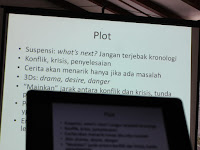 Further, there are some points noted in writing fiction,first, the story is an event that 'disturb' thoughts, conflicts, dilemmas or irregularities that occur.Second, the plot, the story contains conflicts, crises and solutions, which include 3D, drama (something attractive), desire and danger (something challenging). In this section the author needs to 'play' distance between conflict, crisis and solving, so that the reader is curious about the story. Third, related with characterization, there is keyword 'seeing is believing' that the writer should be able to present the character in the fiction story clearly so that the reader feel the real interaction with the character. Fourth, point of view of the story, the first person or third person. Each has its own advantages. Fifth, the background of the story correlates with time and place of story. It should be specific, real and historical so the reader feels something real and engages in the story although it is just fiction. Finally, the opening and closing, the author can make the opening and closing of the story gradually or shocking the readers for the effectiveness when delivering messages of ther story. Sometimes the ending of the story is a 'disturbing' ending that keeps the reader thinking about the story.
Further, there are some points noted in writing fiction,first, the story is an event that 'disturb' thoughts, conflicts, dilemmas or irregularities that occur.Second, the plot, the story contains conflicts, crises and solutions, which include 3D, drama (something attractive), desire and danger (something challenging). In this section the author needs to 'play' distance between conflict, crisis and solving, so that the reader is curious about the story. Third, related with characterization, there is keyword 'seeing is believing' that the writer should be able to present the character in the fiction story clearly so that the reader feel the real interaction with the character. Fourth, point of view of the story, the first person or third person. Each has its own advantages. Fifth, the background of the story correlates with time and place of story. It should be specific, real and historical so the reader feels something real and engages in the story although it is just fiction. Finally, the opening and closing, the author can make the opening and closing of the story gradually or shocking the readers for the effectiveness when delivering messages of ther story. Sometimes the ending of the story is a 'disturbing' ending that keeps the reader thinking about the story.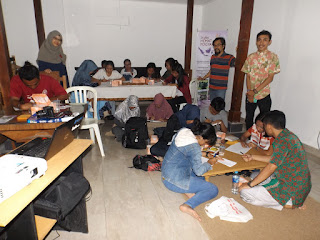 In the next session the participants practiced writing fiction. They beganto imagine an idea or inspiration, then writing the opening of a fictional story. There were some participants who wrote stories that were able to provoke the reader's curiosity, such as Anggita Getza's writing about the mystical incident and David Pamerean about the explosion in outer space.
In the next session the participants practiced writing fiction. They beganto imagine an idea or inspiration, then writing the opening of a fictional story. There were some participants who wrote stories that were able to provoke the reader's curiosity, such as Anggita Getza's writing about the mystical incident and David Pamerean about the explosion in outer space.
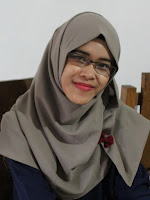 At the end of the event, Sulistyaningtyas, a young writer known as Tyas Effendi, who wrote several books, such as ‘Tentang Waktu’, ‘Catatan Musim’, ‘Life After You’ and ‘Dance for Two’ gave her books to lucky participants as appreciations. She also shared her writing experience with her perseverence to write and learn, smart to choosetrending theme for readers and learn the characteristic of publishers.
At the end of the event, Sulistyaningtyas, a young writer known as Tyas Effendi, who wrote several books, such as ‘Tentang Waktu’, ‘Catatan Musim’, ‘Life After You’ and ‘Dance for Two’ gave her books to lucky participants as appreciations. She also shared her writing experience with her perseverence to write and learn, smart to choosetrending theme for readers and learn the characteristic of publishers.
Culture and Modernization A visit to Gusdurian community
Tuesday, 31 October 2017by adminstube
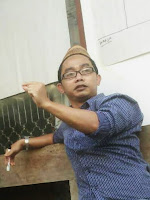 On Tuesday, October 31, 2017, with a theme of discussion ‘Culture and Modernization’, Jay Akhmad, the lighters of ‘Ngaji Gus Dur #8 this afternoon’ at Griya Gusdurian Jogja, presented Gus Dur's articles written in 80-90s about ‘the position of our cultural system (Indonesia) and the influence of modernization’
On Tuesday, October 31, 2017, with a theme of discussion ‘Culture and Modernization’, Jay Akhmad, the lighters of ‘Ngaji Gus Dur #8 this afternoon’ at Griya Gusdurian Jogja, presented Gus Dur's articles written in 80-90s about ‘the position of our cultural system (Indonesia) and the influence of modernization’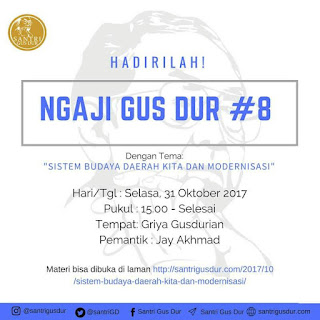 According to Gus Dur and based onLIPI studies, there are fourteen regional cultural systems from Aceh to East Nusa Tenggara. These cultural systemsare still used in the presence of unpredictable modernity. One example, Ngada culture of Manggarai could substitute the function of legal modern court before its existence in modern era. In the context of islamic boarding school, Kyaitook part as a filter of all information input and culture rush before he disseminated to public to protect them from negative impacts. Consideringpeople’s various reactions in facing modernity, especially in Indonesia with various cultural background and society life, filtering and protection is important.
According to Gus Dur and based onLIPI studies, there are fourteen regional cultural systems from Aceh to East Nusa Tenggara. These cultural systemsare still used in the presence of unpredictable modernity. One example, Ngada culture of Manggarai could substitute the function of legal modern court before its existence in modern era. In the context of islamic boarding school, Kyaitook part as a filter of all information input and culture rush before he disseminated to public to protect them from negative impacts. Consideringpeople’s various reactions in facing modernity, especially in Indonesia with various cultural background and society life, filtering and protection is important.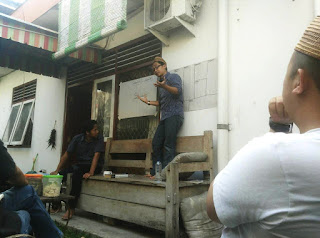 Modernity is very close to technology and information,and one of the products of modernity is education curriculum. Formerly, Pondok Pesantren (Islamic boarding school) had no curriculum as there was only ‘pengajian’ (reading Quran) and the santris learned something from Kyai, even their graduation depended on him. Some of them were graduated quickly, some others hadto stay longer. As time goes by, there are still Islamic boarding schools that still hold old model with no curriculum and only reading Quran. One of them is Salafiyyah. There are also semi-modern onesthat combine recitation and curriculum but some others are with modern curriculum as formal schools.
Modernity is very close to technology and information,and one of the products of modernity is education curriculum. Formerly, Pondok Pesantren (Islamic boarding school) had no curriculum as there was only ‘pengajian’ (reading Quran) and the santris learned something from Kyai, even their graduation depended on him. Some of them were graduated quickly, some others hadto stay longer. As time goes by, there are still Islamic boarding schools that still hold old model with no curriculum and only reading Quran. One of them is Salafiyyah. There are also semi-modern onesthat combine recitation and curriculum but some others are with modern curriculum as formal schools.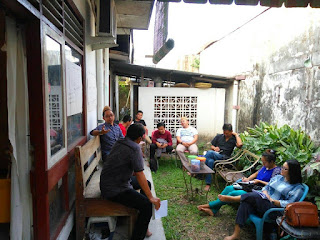 Indah, from Medan shared Sinamottradition in Batak marriage cultures. Sinamot is also dowry prepared by the groom to bride. Formerly the form of Sinamot islivestock dan farm products, but now, Sinamot is given in amounts of money. One participant from Java did not miss the discussion by giving information about marriage system in Java which still consider the date of birth, called‘weton’. It is believed if ‘weton’ of the couple is not appropriate, the couple can not get married. But now, most people tend to be practical and no longerto involve the calculation of ‘weton’ in marriage.
Indah, from Medan shared Sinamottradition in Batak marriage cultures. Sinamot is also dowry prepared by the groom to bride. Formerly the form of Sinamot islivestock dan farm products, but now, Sinamot is given in amounts of money. One participant from Java did not miss the discussion by giving information about marriage system in Java which still consider the date of birth, called‘weton’. It is believed if ‘weton’ of the couple is not appropriate, the couple can not get married. But now, most people tend to be practical and no longerto involve the calculation of ‘weton’ in marriage.
Women as a Peace Agent
Thursday, 12 October 2017by adminstube
 Maria Ida L. Giguiento, commonly called Bu Deng,the training coordinator for The Peace and Reconciliation Program of Catholic Relief Services Philippines, stated, “One of the goals that SRILI is trying to build is givingcontribution to conflict reconciliation and givinginformation how importantof tolerance education".According to Bu Deng,people who want to be active peacebuilders should know exactly what conflicts they are facing about.To gain this capability requires analysis ability. For example, when someone enters university,actually he or she is going to Universal-City. So he/she has to understand the reason why he/she enters university, why he/she studies a specific subject, what he/she looks for in campus, in other word, everything should be considered. Besides, he/she also should know what is going on around him/her, what benefits he/she will get in campus andbe familiar with problems that happen in Universal-City. The presentation of her material was so simple to build women awareness to be involved in peace building. Building peace is an effort to transform issues, relationships and institution/structure; reducing possibility of increasing conflict that lead to violence. "If we want to build peace, first we should establish positive relationship with others", Bu Deng emphasized.
Maria Ida L. Giguiento, commonly called Bu Deng,the training coordinator for The Peace and Reconciliation Program of Catholic Relief Services Philippines, stated, “One of the goals that SRILI is trying to build is givingcontribution to conflict reconciliation and givinginformation how importantof tolerance education".According to Bu Deng,people who want to be active peacebuilders should know exactly what conflicts they are facing about.To gain this capability requires analysis ability. For example, when someone enters university,actually he or she is going to Universal-City. So he/she has to understand the reason why he/she enters university, why he/she studies a specific subject, what he/she looks for in campus, in other word, everything should be considered. Besides, he/she also should know what is going on around him/her, what benefits he/she will get in campus andbe familiar with problems that happen in Universal-City. The presentation of her material was so simple to build women awareness to be involved in peace building. Building peace is an effort to transform issues, relationships and institution/structure; reducing possibility of increasing conflict that lead to violence. "If we want to build peace, first we should establish positive relationship with others", Bu Deng emphasized.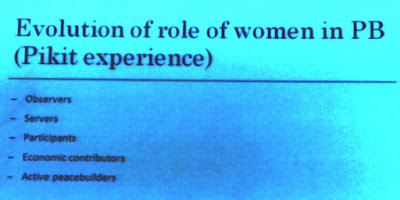 As time goes by, the role of women in peace-building continues to evolve,startingfrom just being an observer outside the window when men have meeting, next serving as waiter in the kitchen to take care the meal for men's meeting, then interestis growing to be involved by attending meeting held in church, village and social groups. When women areinvolved and communicate with men, there are spaces that can be used to increase women's capacity so they can claim the space controlled by men as their space as well, although it is admitted that womenstill have limitation in peace building.
As time goes by, the role of women in peace-building continues to evolve,startingfrom just being an observer outside the window when men have meeting, next serving as waiter in the kitchen to take care the meal for men's meeting, then interestis growing to be involved by attending meeting held in church, village and social groups. When women areinvolved and communicate with men, there are spaces that can be used to increase women's capacity so they can claim the space controlled by men as their space as well, although it is admitted that womenstill have limitation in peace building.Book Review: ‘How to Survive Change You Didn’t Ask For’
Wednesday, 11 October 2017by adminstube
 The review of the book having 5 chapters entitled"How to Survive Change You Did not Ask For" (10.10.2017) by Elizabeth Uru Ndaya helps students to know some tips how to react appropriately and tosurvive because of unwanted changes. This book was written by M.J. Ryan, a motivator and an initiator of Random Acts of Kindnessfrom the New York Time. Some other books she wrote are The Power of Patience, The Happiness Makeover, and Attitudes of Gratitude, and many other motivational books. In her book, the author offers how to get out from suffering more quickly by preparing the right mindset and attitude. First, when a changing happens we must accept it with a big heart. Second, if wehave been able to accept it, then we begin to develop options that can be chosen as the right solution to solve the problems. Most people failed to face changing because they are not able to develop options and using old options, so they aregulped by the changes. Third, once we find the right options and chose a solution, we have to take actionto get out from the problem. Fourth, soon after we have made an action, we must reinforce our adaptability so we will be able to predict the changes that will happen and then take the right position to deal with it.
The review of the book having 5 chapters entitled"How to Survive Change You Did not Ask For" (10.10.2017) by Elizabeth Uru Ndaya helps students to know some tips how to react appropriately and tosurvive because of unwanted changes. This book was written by M.J. Ryan, a motivator and an initiator of Random Acts of Kindnessfrom the New York Time. Some other books she wrote are The Power of Patience, The Happiness Makeover, and Attitudes of Gratitude, and many other motivational books. In her book, the author offers how to get out from suffering more quickly by preparing the right mindset and attitude. First, when a changing happens we must accept it with a big heart. Second, if wehave been able to accept it, then we begin to develop options that can be chosen as the right solution to solve the problems. Most people failed to face changing because they are not able to develop options and using old options, so they aregulped by the changes. Third, once we find the right options and chose a solution, we have to take actionto get out from the problem. Fourth, soon after we have made an action, we must reinforce our adaptability so we will be able to predict the changes that will happen and then take the right position to deal with it. Some of the twenty tips offered in chapter four are: speaking personally to God that you believe about the burdens, notstaying alone butfinding friends, ordoing interactionwith happy peopleto get positive energy, etc.
Some of the twenty tips offered in chapter four are: speaking personally to God that you believe about the burdens, notstaying alone butfinding friends, ordoing interactionwith happy peopleto get positive energy, etc. The discussionparticipated bythirteen people is actually a start ofthe Survival Competency program which will be held in November. There are some stories that participants told how they survive with problems. Maritjie shared, "Two weeks ago there was a Facebook account thatpublished satirical postings by re-copying onestatus I wrote. I was panicked at first and confused but when I began to be able to handle myself well,the problem can be solved gradually". Sari also told her incident, "While I was in the process of doing campus tasks with just two-day deadline,someone stole my laptop. It's very hard time actually, however instead of complaining and grumbling, it's better to find a solution to finish the tasks on time".
The discussionparticipated bythirteen people is actually a start ofthe Survival Competency program which will be held in November. There are some stories that participants told how they survive with problems. Maritjie shared, "Two weeks ago there was a Facebook account thatpublished satirical postings by re-copying onestatus I wrote. I was panicked at first and confused but when I began to be able to handle myself well,the problem can be solved gradually". Sari also told her incident, "While I was in the process of doing campus tasks with just two-day deadline,someone stole my laptop. It's very hard time actually, however instead of complaining and grumbling, it's better to find a solution to finish the tasks on time".Know more about LPDP Scholarship
Wednesday, 4 October 2017by adminstube

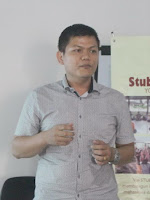 Stube-HEMAT, as a youth mentoring institution invited Hamonangan Malau a student of Master of Development Economics of UGM, the Coordinator of LPDP socialization in Jogja; Daud Yaferson Dollu, a student of Master of Law Litigation UGM; and Fridrik Makanlehi, a students of Master of Transportation System and Engineering UGM, to share and have discussion entitled ‘know more about LPDP scholarship’ on Tuesday, October 3, 2017 at the Stube-HEMAT Yogyakarta Secretariat. The three of them are also the recipients of the scholarship from the institution. For details about this institution please read: (http://www.lpdp.kemenkeu.go.id/profile/history/).
Stube-HEMAT, as a youth mentoring institution invited Hamonangan Malau a student of Master of Development Economics of UGM, the Coordinator of LPDP socialization in Jogja; Daud Yaferson Dollu, a student of Master of Law Litigation UGM; and Fridrik Makanlehi, a students of Master of Transportation System and Engineering UGM, to share and have discussion entitled ‘know more about LPDP scholarship’ on Tuesday, October 3, 2017 at the Stube-HEMAT Yogyakarta Secretariat. The three of them are also the recipients of the scholarship from the institution. For details about this institution please read: (http://www.lpdp.kemenkeu.go.id/profile/history/).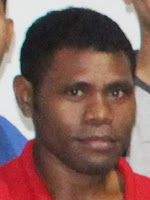 "Good news for applicants who come from East Sumba Regency. Since East Sumba Regent has made MOU with LPDP to send 50 people every year to register LPDP", said Fridrik. Some tips to join the selection of LPDP such as body language, attitude, style and manners are also presented during the discussion on that afternoon.
"Good news for applicants who come from East Sumba Regency. Since East Sumba Regent has made MOU with LPDP to send 50 people every year to register LPDP", said Fridrik. Some tips to join the selection of LPDP such as body language, attitude, style and manners are also presented during the discussion on that afternoon.Open New Network and Be Sensitive to Conflict
Saturday, 30 September 2017by adminstube
 As realization to open and strengthen the network, a group of students activists Stube-HEMAT Yogyakarta consists of Robertus Letigalli, Siprianus Ndawa Lu, Anna Astri Don and Redy Hartantoinitiated to hold a discussion with KMK Unriyo students on Friday, September 29, 2017 at Unriyo campus, Kledokan with a topic on “Student andConflict Mapping”.
As realization to open and strengthen the network, a group of students activists Stube-HEMAT Yogyakarta consists of Robertus Letigalli, Siprianus Ndawa Lu, Anna Astri Don and Redy Hartantoinitiated to hold a discussion with KMK Unriyo students on Friday, September 29, 2017 at Unriyo campus, Kledokan with a topic on “Student andConflict Mapping”. There were twenty-six participants attended this discussion, consisting of KMK Unriyo students, STAK Marturia, follow-up group and Stube-HEMAT Yogyakarta team. Yulius, the chairman of KMK Unriyo in his opening greeting expressed his joy and grateful for the cooperation. He hoped that this discussion would run well and all participants were able to learn together. In the introductory session, the participants introduced name, origin area and field of study. Apparently, almost 90% of participants came from outside of Java island.
There were twenty-six participants attended this discussion, consisting of KMK Unriyo students, STAK Marturia, follow-up group and Stube-HEMAT Yogyakarta team. Yulius, the chairman of KMK Unriyo in his opening greeting expressed his joy and grateful for the cooperation. He hoped that this discussion would run well and all participants were able to learn together. In the introductory session, the participants introduced name, origin area and field of study. Apparently, almost 90% of participants came from outside of Java island. Next, Trustha Rembaka, thecoordinator of Stube-HEMAT Yogyakarta introduced Stube-HEMAT and its activities that build awareness of young people and students to understand the surrounding social issues. He invited students not to 'separate themselves' from the surrounding community, but to be 'involved' in thecommunity dynamics wherever they lived. He added that this discussion was a follow up of Peace Studies training followed by Robertus and his friends a few weeks earlier.
Next, Trustha Rembaka, thecoordinator of Stube-HEMAT Yogyakarta introduced Stube-HEMAT and its activities that build awareness of young people and students to understand the surrounding social issues. He invited students not to 'separate themselves' from the surrounding community, but to be 'involved' in thecommunity dynamics wherever they lived. He added that this discussion was a follow up of Peace Studies training followed by Robertus and his friends a few weeks earlier. Redy Hartanto, one of the member of the follow-up group, delivered atopic of Student and Conflict. During the process,participants were asked to give opinion about what causes conflict. In fact, student may be a cause of conflict or may be aconflict resolution actor. He explained thatalthough conflict is negative and disadvantageous,it still has positive side. Is it true? Yes! Negative impacts of conflict are disputes, hatred and even violence, while the positive sides of conflict are both parties in conflict will sharpen mind and deepen knowledge to recognize and to map the conflict to find various solutions of theirconflict.
Redy Hartanto, one of the member of the follow-up group, delivered atopic of Student and Conflict. During the process,participants were asked to give opinion about what causes conflict. In fact, student may be a cause of conflict or may be aconflict resolution actor. He explained thatalthough conflict is negative and disadvantageous,it still has positive side. Is it true? Yes! Negative impacts of conflict are disputes, hatred and even violence, while the positive sides of conflict are both parties in conflict will sharpen mind and deepen knowledge to recognize and to map the conflict to find various solutions of theirconflict.
Meet each other Learn and Share
Wednesday, 27 September 2017by adminstube
 Direct interaction with other people with different cultures definitely provides new experiences and learning for each party about the diversity in Indonesia with regional promotion in local context. It is what prompts Stube-HEMAT Yogyakarta to give student activist of Stube a chance to visit Sumba, one of islands in East Nusa Tenggara. Three students were dare to accept the challenge, who were they?
Direct interaction with other people with different cultures definitely provides new experiences and learning for each party about the diversity in Indonesia with regional promotion in local context. It is what prompts Stube-HEMAT Yogyakarta to give student activist of Stube a chance to visit Sumba, one of islands in East Nusa Tenggara. Three students were dare to accept the challenge, who were they? First, Dominggus Urkora, a student of Theology at STAK Marturia Yogyakarta, originated from Dobo, Southeast Maluku. Domi was sent toSumba and staying precisely in Kanjonga Bakul village, Nggaha Ori Angu, East Sumba between 17 June to 17 July 2017 by conductingactivities related to Sunday School in GKS Kanjonga Bakul.
First, Dominggus Urkora, a student of Theology at STAK Marturia Yogyakarta, originated from Dobo, Southeast Maluku. Domi was sent toSumba and staying precisely in Kanjonga Bakul village, Nggaha Ori Angu, East Sumba between 17 June to 17 July 2017 by conductingactivities related to Sunday School in GKS Kanjonga Bakul.

 His first activity was collecting the biodata of GKS Kanjonga BakulSunday school children from five groups covering Kanjonga Bakul, Horani, Kalu, Walakiri and Bidiwai. Next,motivating new teachers to serve Sunday school, and then watching movies for children. During his interaction in the field, Domi found that some elementary school children were not able to read yet, so he was driven to hold activities on literacy assistance. Actually, it was not an easy activity as he had to pass the rocky path to reach the villages, however Domi was happy when the boys called out his name as they passedacross on the path.
His first activity was collecting the biodata of GKS Kanjonga BakulSunday school children from five groups covering Kanjonga Bakul, Horani, Kalu, Walakiri and Bidiwai. Next,motivating new teachers to serve Sunday school, and then watching movies for children. During his interaction in the field, Domi found that some elementary school children were not able to read yet, so he was driven to hold activities on literacy assistance. Actually, it was not an easy activity as he had to pass the rocky path to reach the villages, however Domi was happy when the boys called out his name as they passedacross on the path.
 Second, Nova Yulanda Putri Sipahutar, an alumnus of Gadjah Mada University, Yogyakarta, comingfrom North Sumatra held anassistance for early childhood education of Nasareth, Tanggamadita, East Sumba. This early childhood education was established in 2014 and registered in the East Sumba Education Office in 2016. However, the activity was still conductedat a room of Posyandu Tanggamadita, because itdidn’t have its own building. So far, there were 18 students registered until July 2017.
Second, Nova Yulanda Putri Sipahutar, an alumnus of Gadjah Mada University, Yogyakarta, comingfrom North Sumatra held anassistance for early childhood education of Nasareth, Tanggamadita, East Sumba. This early childhood education was established in 2014 and registered in the East Sumba Education Office in 2016. However, the activity was still conductedat a room of Posyandu Tanggamadita, because itdidn’t have its own building. So far, there were 18 students registered until July 2017.
 In the same place, Nova held English classes for elementary, junior and senior high school students. Because participants have to draw water and collect firewood for their home needs, or also along with school daytime schedules, they often came late. However, they were eager to learnseveral topics,such as alphabet in English, family, basic introduction, subject, to be, object, and possesion. The results appeared when they were dare to perform short English conversations, mentioning vocabularies and writing sentences according to English sentence structures.
In the same place, Nova held English classes for elementary, junior and senior high school students. Because participants have to draw water and collect firewood for their home needs, or also along with school daytime schedules, they often came late. However, they were eager to learnseveral topics,such as alphabet in English, family, basic introduction, subject, to be, object, and possesion. The results appeared when they were dare to perform short English conversations, mentioning vocabularies and writing sentences according to English sentence structures.

 Student Reading Group was also a concern of Nova. There were five female students who joined, namely Betriks Lay, Elisabeth Bangi Lida, Yustiwati, Onira Tangga Nalu and Melianti Betsdwi. The name of this group was Anala'du, meaning the sun symbolizing a woman, because the books they readare about womenwith women perspective, such as Tabula Rasa, Gadis Pantai, Go To Set A Watchman, Entrok, and Memang Jodoh. The group agreed that each member is a facilitator and discussion participants. In each discussion, the facilitator provided a resume and analysis of the book in Sumba context and continued by questions and answers.
Student Reading Group was also a concern of Nova. There were five female students who joined, namely Betriks Lay, Elisabeth Bangi Lida, Yustiwati, Onira Tangga Nalu and Melianti Betsdwi. The name of this group was Anala'du, meaning the sun symbolizing a woman, because the books they readare about womenwith women perspective, such as Tabula Rasa, Gadis Pantai, Go To Set A Watchman, Entrok, and Memang Jodoh. The group agreed that each member is a facilitator and discussion participants. In each discussion, the facilitator provided a resume and analysis of the book in Sumba context and continued by questions and answers. Third, Redy Hartanto, a theology student of STAK Marturia Yogyakarta from Lampung had an idea to teach the Sunday school creatively by utilizing the surrounding localobjects. On 15 July 2017-12 August 2017 he was in Sumba, precisely at GKS Laihau, LewaeTidas, East Sumba.
Third, Redy Hartanto, a theology student of STAK Marturia Yogyakarta from Lampung had an idea to teach the Sunday school creatively by utilizing the surrounding localobjects. On 15 July 2017-12 August 2017 he was in Sumba, precisely at GKS Laihau, LewaeTidas, East Sumba.
 He used banana leaves as children's activity and plastic straws as teaching aid on particular topics. In addition, he also listed Sundayschool children, motivated teenagers to become a Sunday school teacher, held movie for children and held acompetition for Sunday school children. Redy was sick on his first day arrival, but eventually he got his strength and succeeded in motivating four young people to take part in Sunday school service at GKS Laihau.
He used banana leaves as children's activity and plastic straws as teaching aid on particular topics. In addition, he also listed Sundayschool children, motivated teenagers to become a Sunday school teacher, held movie for children and held acompetition for Sunday school children. Redy was sick on his first day arrival, but eventually he got his strength and succeeded in motivating four young people to take part in Sunday school service at GKS Laihau.
Dare to Share knowledge of conflict management A follow-up activity of peace study training
Monday, 25 September 2017by adminstube
 One specific thing of Stube-HEMAT Yogyakarta after a training is giving encourage to each participant to design and conduct a follow-up activity.Last September 8-10, 2017 Stube-HEMAT Yogyakarta organized a Peace Study training entitled against the failure to react.
One specific thing of Stube-HEMAT Yogyakarta after a training is giving encourage to each participant to design and conduct a follow-up activity.Last September 8-10, 2017 Stube-HEMAT Yogyakarta organized a Peace Study training entitled against the failure to react. One group consisting of Ni Putu Sari Yani Darsani, Adi Zamba, Monika Zangga Nata, Imelda Hada Inda, Junerin Kaleka and Marthia Sari Rato, shared their experiences they learned during the training on peace studies, at STPMD APMD campus on Saturday 23/09/2017. They discussed the topic with students who joined Hipmasty, a student associationof East Sumba students in Yogyakarta. The implementation of this activity is driven by the interest of the participants and the need to share knowledge for others.
One group consisting of Ni Putu Sari Yani Darsani, Adi Zamba, Monika Zangga Nata, Imelda Hada Inda, Junerin Kaleka and Marthia Sari Rato, shared their experiences they learned during the training on peace studies, at STPMD APMD campus on Saturday 23/09/2017. They discussed the topic with students who joined Hipmasty, a student associationof East Sumba students in Yogyakarta. The implementation of this activity is driven by the interest of the participants and the need to share knowledge for others. During the process,participants were so enthusiastic to argue and to defend their arguments. Then, they were divided in two groups to prepare role play and triedto find a conflict in their surrounding. Further, they analyzed it and then madea mapping of related parties, as if a conflictmediator by paying attention to the materials had been presented by two previous speakers.
During the process,participants were so enthusiastic to argue and to defend their arguments. Then, they were divided in two groups to prepare role play and triedto find a conflict in their surrounding. Further, they analyzed it and then madea mapping of related parties, as if a conflictmediator by paying attention to the materials had been presented by two previous speakers. Group 1 found aproblem aboutstudents’ awareness to engage and learn in an organization, especially Hipmasty as learning material in their group discussion. Group 2 discussed issue on construction of sugar cane plantation in East Sumba. The findings and analysis of the groups were presented together. Marthia Sari Rato, representative of the speakers, expressed her satisfaction and happiness for the enthusiasm of the participants and the implementation of this follow-up activity.
Group 1 found aproblem aboutstudents’ awareness to engage and learn in an organization, especially Hipmasty as learning material in their group discussion. Group 2 discussed issue on construction of sugar cane plantation in East Sumba. The findings and analysis of the groups were presented together. Marthia Sari Rato, representative of the speakers, expressed her satisfaction and happiness for the enthusiasm of the participants and the implementation of this follow-up activity. "I am very satisfied with this follow-up as we can share our experience on conflict management and delivered like a small training for Hipmasty members. We are alsohappy to see that all participants were very enthusiastic joining this follow-up. Thank you so much to Hipmasty members having allocatedtheir time to attend and to discuss together.The last but not the least, thank you Stube-HEMAT Yogyakarta. We practiced as trainers", Sari concluded. (MAR).
"I am very satisfied with this follow-up as we can share our experience on conflict management and delivered like a small training for Hipmasty members. We are alsohappy to see that all participants were very enthusiastic joining this follow-up. Thank you so much to Hipmasty members having allocatedtheir time to attend and to discuss together.The last but not the least, thank you Stube-HEMAT Yogyakarta. We practiced as trainers", Sari concluded. (MAR).Let’s Take Action, Students!
Friday, 15 September 2017by adminstube
 Eko Prasetyo wrote a book ‘Bergeraklah Mahasiswa!” (Let’s Take Action, Students!) as a criticism to students as well as education system. This situation pushed Social Movements Institute (SMI) together with Togamas Bookstore, Tribun Forum, Tribun Jogja, and Stube-HEMAT to review this book on Thursday, September 14, 2017 at Togamas Gejayan Bookstore.
Eko Prasetyo wrote a book ‘Bergeraklah Mahasiswa!” (Let’s Take Action, Students!) as a criticism to students as well as education system. This situation pushed Social Movements Institute (SMI) together with Togamas Bookstore, Tribun Forum, Tribun Jogja, and Stube-HEMAT to review this book on Thursday, September 14, 2017 at Togamas Gejayan Bookstore.Against The Failure To React
Monday, 11 September 2017by adminstube

 The first session was opened with introduction of Stube-HEMAT Yogyakarta by Ariani Narwastujati, S.Pd., S.S., M.Pd,the Executive Director of Stube-HEMAT Indonesia. The second session invited participants to understand basic theory of Conflict Management conveyed by Sarloce Apang, S.T, Trustha Rembaka, S.Th and Rudyolof I.M. Pinda, S.Sos. Based on the presentation, the participants are motivated to understand and analyze conflict, find key person, and even learned how to create conflict in order to make it visible and able to find solutioneventually.
The first session was opened with introduction of Stube-HEMAT Yogyakarta by Ariani Narwastujati, S.Pd., S.S., M.Pd,the Executive Director of Stube-HEMAT Indonesia. The second session invited participants to understand basic theory of Conflict Management conveyed by Sarloce Apang, S.T, Trustha Rembaka, S.Th and Rudyolof I.M. Pinda, S.Sos. Based on the presentation, the participants are motivated to understand and analyze conflict, find key person, and even learned how to create conflict in order to make it visible and able to find solutioneventually. Some experienced facilitators were invited to complete this three days training. Yoga Khoiri Ali, M.A, from Terrorism Prevention Coordination Forum (FKPT) of Yogyakarta Special Region conveyed understanding on how foreign sides are trying to control Indonesia through various tactics, one of them is religion issue. This issue is 'played' to disrupt us. Based on the research, the main trigger of the conflict in equatorial area, including Indonesia is energy crisis. The religion issue was deliberately played to create conflict as the diversion while energy resource fights were taking place.
Some experienced facilitators were invited to complete this three days training. Yoga Khoiri Ali, M.A, from Terrorism Prevention Coordination Forum (FKPT) of Yogyakarta Special Region conveyed understanding on how foreign sides are trying to control Indonesia through various tactics, one of them is religion issue. This issue is 'played' to disrupt us. Based on the research, the main trigger of the conflict in equatorial area, including Indonesia is energy crisis. The religion issue was deliberately played to create conflict as the diversion while energy resource fights were taking place.
 As important entryto be smart in facing issues on ethnicity, religion, race and inter-group relation and hoax issues in media, Rifqiya Hidayatul Mufidah and Sarjoko from Gusdurian, equipped participants' understanding with their material. Rifqiya shared about Gusdurian Community and what they do, while Sarjoko gave important exposure on how media really fool us with 'hoax' news and SARA issues that are deliberately made based on client request. Once an issue blown, they get large amount of money. While, we are as consumers of the news can only blame and curse each other.
As important entryto be smart in facing issues on ethnicity, religion, race and inter-group relation and hoax issues in media, Rifqiya Hidayatul Mufidah and Sarjoko from Gusdurian, equipped participants' understanding with their material. Rifqiya shared about Gusdurian Community and what they do, while Sarjoko gave important exposure on how media really fool us with 'hoax' news and SARA issues that are deliberately made based on client request. Once an issue blown, they get large amount of money. While, we are as consumers of the news can only blame and curse each other.Establishing Constructive Interfaith Interaction
Tuesday, 29 August 2017by adminstube
 An opening discussion organized by Stube-HEMAT Yogyakarta to initiate Peace Studies program: Conflict Management and Resolution, on Monday, August 28, 2017 was interesting. Why? The speaker in the discussion was Ustadz Hasyim Abdullah, S.E, an author and practitioner of Islamic teaching (dakwah) who spoke among Christian students. As a member of FKUB(interfaith forum for harmony) of Yogyakarta special region, Ustadz Hasyim gave positive appreciation for the activities carried out by Stube-HEMAT Yogyakarta because it opened space forinteraction between Islamic leader and Christian youths. Such interaction will melt the communication between groups and will foster mutual trust.
An opening discussion organized by Stube-HEMAT Yogyakarta to initiate Peace Studies program: Conflict Management and Resolution, on Monday, August 28, 2017 was interesting. Why? The speaker in the discussion was Ustadz Hasyim Abdullah, S.E, an author and practitioner of Islamic teaching (dakwah) who spoke among Christian students. As a member of FKUB(interfaith forum for harmony) of Yogyakarta special region, Ustadz Hasyim gave positive appreciation for the activities carried out by Stube-HEMAT Yogyakarta because it opened space forinteraction between Islamic leader and Christian youths. Such interaction will melt the communication between groups and will foster mutual trust.Going to Explore Taiwan
Monday, 28 August 2017by adminstube
 The goal of I Love Taiwan or ILT isgiving young people chances to know each other and tobuild a network started with ‘Thy Name’ (Your Name). By knowing name, people will know each other and are expected to be more familiar with the creator, the Lord. This event was also held to commemorate 500 years of church reformation. "This celebration is also to gather young people from different countries whohave soul to care each other and to take part in ministry by sharing and studying at local churches in Taiwan. Young people can learn other countries’ cultures, especially the life and struggle of churches facing social problems in society", Jimmy explained.
The goal of I Love Taiwan or ILT isgiving young people chances to know each other and tobuild a network started with ‘Thy Name’ (Your Name). By knowing name, people will know each other and are expected to be more familiar with the creator, the Lord. This event was also held to commemorate 500 years of church reformation. "This celebration is also to gather young people from different countries whohave soul to care each other and to take part in ministry by sharing and studying at local churches in Taiwan. Young people can learn other countries’ cultures, especially the life and struggle of churches facing social problems in society", Jimmy explained.
Approaching Students of ITY
Saturday, 10 June 2017by
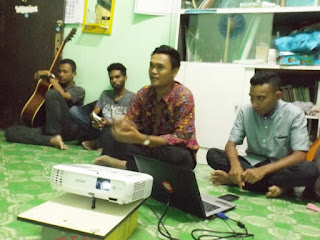 This socialization was attended by 18 students from various faculty of ITY. It was began by a communal worship led by one of the Stube-HEMAT team member with Bible reading taken from Matthew 21: 18 – 35 talking about “Parable of Forgiveness”. What God saying in the chapter wants to teach us that human should forgive each other without any limits. It became a primary factor to maintain peace in the world. Then it is continued with an Introductory Presentation of Stube-HEMAT and its training programs by Mariano Lejap.
This socialization was attended by 18 students from various faculty of ITY. It was began by a communal worship led by one of the Stube-HEMAT team member with Bible reading taken from Matthew 21: 18 – 35 talking about “Parable of Forgiveness”. What God saying in the chapter wants to teach us that human should forgive each other without any limits. It became a primary factor to maintain peace in the world. Then it is continued with an Introductory Presentation of Stube-HEMAT and its training programs by Mariano Lejap.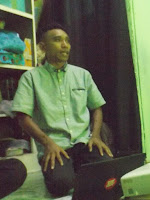 Focusing on Exploring Sumba program, the presentation showed images of activity that previous participants have done. The program is open for all students and it gives opportunity to them to learn about Sumba and share their knowledge. Participants also have time to interact and learn cross-cultural understanding with the local people and Stube-HEMAT activists in Sumba.
Focusing on Exploring Sumba program, the presentation showed images of activity that previous participants have done. The program is open for all students and it gives opportunity to them to learn about Sumba and share their knowledge. Participants also have time to interact and learn cross-cultural understanding with the local people and Stube-HEMAT activists in Sumba.
-
Mahas mahastama.trazz@gmail.com comments.
Kamis, 22 Juni 2017 at 14:29:05
A good post.
-
Mahas mahastama.trazz@gmail.com comments.
Kamis, 22 Juni 2017 at 14:39:14
A good post.
Here I Am, Therefore I Speak
Tuesday, 23 May 2017by adminstube
 To answer the students’ need, Stube-HEMAT Yogyakarta organized a communication skill training program. It began from presenting data with graphic, optimizing power point, until a three-day training with verbal communication practitioner.
To answer the students’ need, Stube-HEMAT Yogyakarta organized a communication skill training program. It began from presenting data with graphic, optimizing power point, until a three-day training with verbal communication practitioner. This three days training with a theme of “Here I am, therefore I Speak” was held in Omah Jawi, Kaliurang guesthouse at 19-21 May 2017. This training was attended by 30 participants from multiple campuses in Yogyakarta. Stube-HEMAT team and Magdalena Betty, a radio broadcaster and also a practitioner of public speaking became the facilitators in this training. Magdalena delivered material, such as, what verbal graffiti is and how to get rid of it. Verbal graffiti is a repeated speaking habit with useless words in the middle of speaking like ‘ehmm’, ‘eee’, ‘maybe, ‘mmmm’, etc. Other materials delivered were verbal and non-verbal communication and the proper way to express opinion. Participants were also trained to analyze assumption and fact sentences to help objectivity thinking and conclusion making.
This three days training with a theme of “Here I am, therefore I Speak” was held in Omah Jawi, Kaliurang guesthouse at 19-21 May 2017. This training was attended by 30 participants from multiple campuses in Yogyakarta. Stube-HEMAT team and Magdalena Betty, a radio broadcaster and also a practitioner of public speaking became the facilitators in this training. Magdalena delivered material, such as, what verbal graffiti is and how to get rid of it. Verbal graffiti is a repeated speaking habit with useless words in the middle of speaking like ‘ehmm’, ‘eee’, ‘maybe, ‘mmmm’, etc. Other materials delivered were verbal and non-verbal communication and the proper way to express opinion. Participants were also trained to analyze assumption and fact sentences to help objectivity thinking and conclusion making. The training method didn’t use one way model or teacher-centered learning, but it involved all participants in every session and immediate rehearsal such as debate simulation. The last activity was making a video challenge that required all participants to make 1-5 minute videos with positive invitation as its content. The participants were very creative in making their contents, starting from persuasion to wear helmet when riding, to throw trash in the right place, to be discipline to study, to be aware of HOAX, to avoid smoking, etc. From all videos, 6 top best were chosen.
The training method didn’t use one way model or teacher-centered learning, but it involved all participants in every session and immediate rehearsal such as debate simulation. The last activity was making a video challenge that required all participants to make 1-5 minute videos with positive invitation as its content. The participants were very creative in making their contents, starting from persuasion to wear helmet when riding, to throw trash in the right place, to be discipline to study, to be aware of HOAX, to avoid smoking, etc. From all videos, 6 top best were chosen.
by adminstube
by adminstube
 In the scope of education, presentation is one thing sthat should be mastered and developed by both students and teachers, so the presented material can be understood by the audience. On Saturday 29 April 2017, a sharing about presentation and how to maximize powerpoint was held at Stube-HEMAT Yogyakarta secretariat and attended by fifteen participants from various campuses around Yogyakarta. The participants enthusiastically listened to the material presented by Aditya Wikan Mahastama, S.Kom, M.Cs, an Information Technology lecturer of Duta Wacana Christian University,
In the scope of education, presentation is one thing sthat should be mastered and developed by both students and teachers, so the presented material can be understood by the audience. On Saturday 29 April 2017, a sharing about presentation and how to maximize powerpoint was held at Stube-HEMAT Yogyakarta secretariat and attended by fifteen participants from various campuses around Yogyakarta. The participants enthusiastically listened to the material presented by Aditya Wikan Mahastama, S.Kom, M.Cs, an Information Technology lecturer of Duta Wacana Christian University,
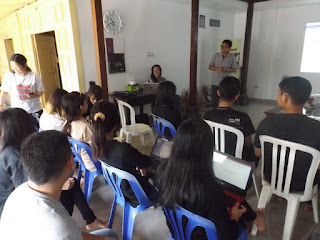 On the other hand, the speaking skills are needed when delivering powerpoints in order to be more interactive and not boring. Examples of interesting powerpoints that the participants have not known yet and how to make it are also presented in this session. Images or animations can be inserted in powerpoint to attract audience’s attention and to keep listening to the material delivered. At the end of the session, the facilitator presented info about unique and more colourful powerpoint design website that can be downloaded freely matching with individual taste.
On the other hand, the speaking skills are needed when delivering powerpoints in order to be more interactive and not boring. Examples of interesting powerpoints that the participants have not known yet and how to make it are also presented in this session. Images or animations can be inserted in powerpoint to attract audience’s attention and to keep listening to the material delivered. At the end of the session, the facilitator presented info about unique and more colourful powerpoint design website that can be downloaded freely matching with individual taste.
Wilton, one of the participants said that this activity encouraged him to be more creative when making powerpoint. If we are able to deliver the material by powerpoint well, of course our presence will be awaited by audience who has ever followed our presentation. (RA).
by adminstube
 Meanwhile, Genocide according to the Convention on the Prevention and Punishment of the Crime of Genocide that is adopted by the UN General Assembly on 9 December 1948 in Paris that is spearheaded by Raphael Lemkin (Polish advocate, Genocide concept inventor), means “… any of the following acts committed with intent to destroy, in whole or in part, a national, ethnical, radical, or religious group, …”. For example: the ethnic massacre in Rwanda and Bosnia.
Meanwhile, Genocide according to the Convention on the Prevention and Punishment of the Crime of Genocide that is adopted by the UN General Assembly on 9 December 1948 in Paris that is spearheaded by Raphael Lemkin (Polish advocate, Genocide concept inventor), means “… any of the following acts committed with intent to destroy, in whole or in part, a national, ethnical, radical, or religious group, …”. For example: the ethnic massacre in Rwanda and Bosnia.
 Why so? Because the basic law to react to the crime against humanity cases (that is used on political victims) depends only on the victim’s record, so the deterrent effect to the grass root perpetrator is insignificant. While genocide focuses on the perpetrator’s point of view, so the modus could be figured out. Thus, action to prevent the desire passing on to the next generation could be done.
Why so? Because the basic law to react to the crime against humanity cases (that is used on political victims) depends only on the victim’s record, so the deterrent effect to the grass root perpetrator is insignificant. While genocide focuses on the perpetrator’s point of view, so the modus could be figured out. Thus, action to prevent the desire passing on to the next generation could be done.
 Prof. Akihisa Matsuno (historian and international law researcher, Osaka University) that came as a speaker said, “It is very important to keep fighting that destruction of political group is seriously treated as genocide, because in the history of mankind, any major crime has a close connection with political motivation”. He also adds further references in the Constitution of the Kingdom of Netherlands, article 1 that says, “Discrimination on the grounds of religion, belief, political opinion, race or sex or on any other grounds whatsoever shall not be permitted”. As a closing statement he added, “Actually, there is no strong reason not to put political victims group into genocide”
Prof. Akihisa Matsuno (historian and international law researcher, Osaka University) that came as a speaker said, “It is very important to keep fighting that destruction of political group is seriously treated as genocide, because in the history of mankind, any major crime has a close connection with political motivation”. He also adds further references in the Constitution of the Kingdom of Netherlands, article 1 that says, “Discrimination on the grounds of religion, belief, political opinion, race or sex or on any other grounds whatsoever shall not be permitted”. As a closing statement he added, “Actually, there is no strong reason not to put political victims group into genocide”
by adminstube
by adminstube
 Observing the importance of chart as a tool to ease up presenting information, Stube HEMAT organized training about chart making on April 22, 2017 in Stube HEMAT Yogyakarta secretariat, attended by 15 participants from different majors and campuses in Yogyakarta. The trainers of the training were Sarloce Apang, S.T. and Indah Theresia, S.E. Both of them are Stube HEMAT Yogyakarta’s work team members.
Observing the importance of chart as a tool to ease up presenting information, Stube HEMAT organized training about chart making on April 22, 2017 in Stube HEMAT Yogyakarta secretariat, attended by 15 participants from different majors and campuses in Yogyakarta. The trainers of the training were Sarloce Apang, S.T. and Indah Theresia, S.E. Both of them are Stube HEMAT Yogyakarta’s work team members.
 Afterward, participant was given time to make chart gradually with their own laptop based on example problem given by the trainer and to do it according to the trainer guidance. The first chart made was the pie chart, followed by column chart, bar chart, and then line chart. The trainer explained it step by step, from using MS Excel to input data before further process into a chart.
Afterward, participant was given time to make chart gradually with their own laptop based on example problem given by the trainer and to do it according to the trainer guidance. The first chart made was the pie chart, followed by column chart, bar chart, and then line chart. The trainer explained it step by step, from using MS Excel to input data before further process into a chart.
Training was finalized by giving the participants tasks to be done by their own. While doing the tasks they needed to analyze which chart that was suitable to the data that they had. With this short training, students were expected to have a better skill to communicate data. (ITM).
by adminstube
by adminstube
by adminstube
by adminstube
 |
|
Agustinus Soleh, observe local tourism potencies in Long Alango village, Bahau Hulu, Malinau, North Kalimantan Province
|
 |
|
Elisabeth Uru Ndaya, observe Sumbanese traditional woven cloth, the symbols, motives, philosophy and its process in East Sumba, East Nusa Tenggara
|
 |
|
Johain Pekaulang the implementation of traditional law in Buli, East Halmahera, North Maluku, to solve criminal cases as time goes by
|
by adminstube
by adminstube
It is true that cooperation will encourage the realization of interaction and in the interaction there is a process of mutual understanding and mutual learning so that there is renewal and progress. Young people, keep interacting in the spirit of togetherness. (TRU).
Vicky’s Reflection on Exploring Sumba The art of acting for Sumba, a gorgeous land
Monday, 27 March 2017by adminstube
 As one of participants of exploring Sumba, I prepared a program namely theater training for youth and students, also including small discussions. Why theater? For me, theater is a medium to make space for youths in their process of capacity development. All hiddendata in their memory and imagination can be lived up and expressed through theater.
As one of participants of exploring Sumba, I prepared a program namely theater training for youth and students, also including small discussions. Why theater? For me, theater is a medium to make space for youths in their process of capacity development. All hiddendata in their memory and imagination can be lived up and expressed through theater.
-
Katie ekaterinanorton18@gmail.com comments.
Jumat, 25 Januari 2019 at 08:54:42
Hello
I enjoy blogging and have just recently written an article on the future of the fashion industry. I would like to contribute it to your blog - feel free to publish it.
You will find the article inside my g drive:
https://drive.google.com/drive/folders/11BKwEwJZapIWy70aDJ0YsOl8SQKpHrDr?usp=sharing
Hopefully, your readers will enjoy it!
Have a good day!
Regards
Katie -
Aly Chiman aly1@alychidesigns.com comments.
Senin, 11 Februari 2019 at 21:06:48
Hello there,
My name is Aly and I would like to know if you would have any interest to have your website here at or.id promoted as a resource on our blog alychidesign.com ?
We are in the midst of updating our broken link resources to include current and up to date resources for our readers. Our resource links are manually approved allowing us to mark a link as a do-follow link as well
.
If you may be interested please in being included as a resource on our blog, please let me know.
Thanks,
Aly
by adminstube
 For more detail about the program services of Stube-HEMAT, Loce played a video about Stube’s activities in 2015 and 2016. After watching the video, a student namely Riyandi asked, how Stube gathered students having different faith and cultures? She explained that Stube-HEMAT keeps contact to approach students with different cultures and religions background by having good relationship with them. If a communication is well established and then we know each other, a trust will be gained. The process of building trust is not instant, however it can be tried eventhough it needs a little bit patience.
For more detail about the program services of Stube-HEMAT, Loce played a video about Stube’s activities in 2015 and 2016. After watching the video, a student namely Riyandi asked, how Stube gathered students having different faith and cultures? She explained that Stube-HEMAT keeps contact to approach students with different cultures and religions background by having good relationship with them. If a communication is well established and then we know each other, a trust will be gained. The process of building trust is not instant, however it can be tried eventhough it needs a little bit patience.
As the conclusion, Sarloce said that Stube does not provide everything students need but Stube is a stepping stone for students to leap further to have experience and personal ability development. (SAP).
by adminstube
 The session was opened by introducing the name and origin of the area, followed by a short video of Stube-HEMAT program. In this visit, Trustha reminded students with three important things that must be possessed by the students. First, knowledge, it is related to students who study and deepen learning materials especially agriculture and forestry, they are really expected to have wide knowledge about agriculture and forestry after graduating. Second, skill, it is closely related to the ability of students to apply or practice what have been learned during their study, so they are really honed and skillful in their field. Third, network, students cannot live alone, they should build relationships with other students, with other people, and other institutions for their optimal development. A network is useful for them while studying and after studying and returning to their hometown. Stube-HEMAT Yogyakarta as an institution mentoring Christian students who study in Yogyakarta, provides space and opportunity for students to learn and develop, not only knowledge but also skills and network through the activities done in Stube-HEMAT Yogyakarta.
The session was opened by introducing the name and origin of the area, followed by a short video of Stube-HEMAT program. In this visit, Trustha reminded students with three important things that must be possessed by the students. First, knowledge, it is related to students who study and deepen learning materials especially agriculture and forestry, they are really expected to have wide knowledge about agriculture and forestry after graduating. Second, skill, it is closely related to the ability of students to apply or practice what have been learned during their study, so they are really honed and skillful in their field. Third, network, students cannot live alone, they should build relationships with other students, with other people, and other institutions for their optimal development. A network is useful for them while studying and after studying and returning to their hometown. Stube-HEMAT Yogyakarta as an institution mentoring Christian students who study in Yogyakarta, provides space and opportunity for students to learn and develop, not only knowledge but also skills and network through the activities done in Stube-HEMAT Yogyakarta.
 Angela Mugar, one of the participant from Borong, Menggarai Timur asked about Local Exposure program, how to access the opportunity as a participant of the program. Trustha explained that the program is open for students who participated actively in Stube-HEMAT Yogyakarta. The candidate should propose what they will do in their hometown during the semester break and then present the proposal to the Stube-HEMAT Yogyakarta team. Next, Nanno Silvano, coming from Larantuka, East Flores, responded that the program of Stube-HEMAT is actually what he is looking for. He has ever joined many activities, but they focus more in spirituality aspect, not answering the needs of local community.
Angela Mugar, one of the participant from Borong, Menggarai Timur asked about Local Exposure program, how to access the opportunity as a participant of the program. Trustha explained that the program is open for students who participated actively in Stube-HEMAT Yogyakarta. The candidate should propose what they will do in their hometown during the semester break and then present the proposal to the Stube-HEMAT Yogyakarta team. Next, Nanno Silvano, coming from Larantuka, East Flores, responded that the program of Stube-HEMAT is actually what he is looking for. He has ever joined many activities, but they focus more in spirituality aspect, not answering the needs of local community.
 "The opportunity to grow of a student is determined by himself/herself, starting from the willingness to have knowledge, to hone skills and to build networks. The process will lead them to grow to be a complete human being, to have personal maturity and to be able to give benefits to others ", said Trustha to end his presentation. Meanwhile Yugo Ardi Saputra, the coordinator of the student group responded positively to the Stube-HEMAT Yogyakarta initiative to go to campus, as one inter-institutional cooperation especially with students in campus. He hopes that the cooperation may continue and be useful for students. (TRU).
"The opportunity to grow of a student is determined by himself/herself, starting from the willingness to have knowledge, to hone skills and to build networks. The process will lead them to grow to be a complete human being, to have personal maturity and to be able to give benefits to others ", said Trustha to end his presentation. Meanwhile Yugo Ardi Saputra, the coordinator of the student group responded positively to the Stube-HEMAT Yogyakarta initiative to go to campus, as one inter-institutional cooperation especially with students in campus. He hopes that the cooperation may continue and be useful for students. (TRU).by adminstube
 The word ‘ekklesia’ in Christian life commonly means to be called out from darkness into the light of Christ to enlighten the darkness of the world. Christians, especially young people need to reflect whether Christian values are still their guide? Is spiritual life and daily life are two separate parts? Have the Christian values embodied in young Christians’ daily life? This was the starting point of Stube-HEMAT Yogyakarta to hold Christianity training program, 10-12 March 2017 at Wisma PPS UKDW Seturan, Yogyakarta. Thirty-two student participants from many regions in Indonesia and from various universities in Yogyakarta joined the training.
The word ‘ekklesia’ in Christian life commonly means to be called out from darkness into the light of Christ to enlighten the darkness of the world. Christians, especially young people need to reflect whether Christian values are still their guide? Is spiritual life and daily life are two separate parts? Have the Christian values embodied in young Christians’ daily life? This was the starting point of Stube-HEMAT Yogyakarta to hold Christianity training program, 10-12 March 2017 at Wisma PPS UKDW Seturan, Yogyakarta. Thirty-two student participants from many regions in Indonesia and from various universities in Yogyakarta joined the training.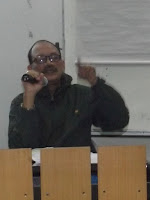 In the opening session Rev. Bambang Sumbodo conveyed Romans 1: 16-17: "For I am not ashamed of the gospel, because it is the power of God for salvation to everyone who believes, first of all the Jews, but also to the Greek. For in it the righteousness of God revealed from faith to faith, as it is written: "The righteous will live by faith." These words reminded young people to return to God's Word, grace, faith and the word of God embodied in everyday life.
In the opening session Rev. Bambang Sumbodo conveyed Romans 1: 16-17: "For I am not ashamed of the gospel, because it is the power of God for salvation to everyone who believes, first of all the Jews, but also to the Greek. For in it the righteousness of God revealed from faith to faith, as it is written: "The righteous will live by faith." These words reminded young people to return to God's Word, grace, faith and the word of God embodied in everyday life.
 Ariani Narwastujati, the Executive Director of Stube-HEMAT said that Stube-HEMAT as institution mentoring students encourages young people, especially college students to improve their knowledge and experience in answering the challenges of both local and international. Their ability is eventually expected to be useful for others around them. So far, Stube-HEMAT is established in Yogyakarta and Sumba, and nowadays there is a Multiplication Program of Stube-HEMAT in Bengkulu.
Ariani Narwastujati, the Executive Director of Stube-HEMAT said that Stube-HEMAT as institution mentoring students encourages young people, especially college students to improve their knowledge and experience in answering the challenges of both local and international. Their ability is eventually expected to be useful for others around them. So far, Stube-HEMAT is established in Yogyakarta and Sumba, and nowadays there is a Multiplication Program of Stube-HEMAT in Bengkulu.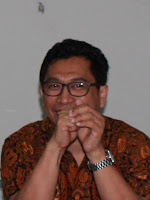 The history of Christianity and church reform undertaken by Martin Luther influenced many regions of Europe and also affected Asia and even Indonesia. One of them is the variety of Christian denominations in Indonesia. This was explained by Pastor Dr. Jozef MN Hehanusa, a lecturer at Post graduate of Duta Wacana Christian University in Yogyakarta. In addition, young people were reminded about the challenges of church to answer the context of the current problems based on Sustainable Development Goals (SDGs) from 2015 – 2030, such as: poverty, food security, healthy life, inclusive and equitable education and gender equality.
The history of Christianity and church reform undertaken by Martin Luther influenced many regions of Europe and also affected Asia and even Indonesia. One of them is the variety of Christian denominations in Indonesia. This was explained by Pastor Dr. Jozef MN Hehanusa, a lecturer at Post graduate of Duta Wacana Christian University in Yogyakarta. In addition, young people were reminded about the challenges of church to answer the context of the current problems based on Sustainable Development Goals (SDGs) from 2015 – 2030, such as: poverty, food security, healthy life, inclusive and equitable education and gender equality.
 Achmad Munjid, a lecturer at Faculty of Cultural Science, Gadjah Mada University revealed that the relationship of Muslims and Christians sometimes did not happen because there was 'barrier' or obstruction, i.e prejudice that emerged between Muslims and Christians themselves. On one hand there is a prejudice among Moslem about a motive to convert people to be Christians, while on the other hand Christians have a prejudice about the establishment of Islamic state. Prejudice arose because they have no experience in interacting together intensively. According to Munjid, the spaces to meet each other should be created so that prejudices will be eliminated and replaced with mutual understanding.
Achmad Munjid, a lecturer at Faculty of Cultural Science, Gadjah Mada University revealed that the relationship of Muslims and Christians sometimes did not happen because there was 'barrier' or obstruction, i.e prejudice that emerged between Muslims and Christians themselves. On one hand there is a prejudice among Moslem about a motive to convert people to be Christians, while on the other hand Christians have a prejudice about the establishment of Islamic state. Prejudice arose because they have no experience in interacting together intensively. According to Munjid, the spaces to meet each other should be created so that prejudices will be eliminated and replaced with mutual understanding. The Christian young people's attitude to the nation was criticized by Brigadier General (Ret) TNI Noeryanto. Christian young people should look back to the past history of the nation and be brave to hold the truth even it has its risks. He revealed his challenge while still serving as army and explained the principles of leadership that should be owned by young people, such as piety, ing ngarsa sung tulada, ing madya mangun karsa, tut wuri handayani, waspada purba wasesa, ambeg paramarta, prasaja, satya, gemi nastiti, blaka and legawa. The meaning are: a leader should set an example, encourage, and give freedom within the corridor, leaders must always be vigilant, humble, modest, loyal, not wasteful, honest and brave to admit mistakes.
The Christian young people's attitude to the nation was criticized by Brigadier General (Ret) TNI Noeryanto. Christian young people should look back to the past history of the nation and be brave to hold the truth even it has its risks. He revealed his challenge while still serving as army and explained the principles of leadership that should be owned by young people, such as piety, ing ngarsa sung tulada, ing madya mangun karsa, tut wuri handayani, waspada purba wasesa, ambeg paramarta, prasaja, satya, gemi nastiti, blaka and legawa. The meaning are: a leader should set an example, encourage, and give freedom within the corridor, leaders must always be vigilant, humble, modest, loyal, not wasteful, honest and brave to admit mistakes. Then, the participants were asked to work in group to formulate Christian values and real problems that occur around them, and then made a reflection whether Christian values could answer it? Further they thought what they can do as light (ekklesia) to answer these problems?
Then, the participants were asked to work in group to formulate Christian values and real problems that occur around them, and then made a reflection whether Christian values could answer it? Further they thought what they can do as light (ekklesia) to answer these problems? Rut Merani, a student participant of STAK Marturia, a theology Institute, from OKU Timur, South Sumatra, said, "I got new knowledge that motivated me to do something in this training. Although I was not so active in the process, the training built my confidence to dare to tell you about myself and my region. I want to do something good for my region."
Rut Merani, a student participant of STAK Marturia, a theology Institute, from OKU Timur, South Sumatra, said, "I got new knowledge that motivated me to do something in this training. Although I was not so active in the process, the training built my confidence to dare to tell you about myself and my region. I want to do something good for my region."by adminstube
by adminstube
 Indah, as a speaker of the socialization was very excited to share her experience joining Stube activities that were usefull to her. In addition of main training programs held in every three months, there are also other programs, such as Exploring Sumba and Local Exposure. Exploring Sumba is a program that gives students an opportunity to visit Sumba and sharing their skills and knowledge they have. While the Local Exposure is a program for students when they spend their holiday in their hometown. During the holidays the participants will do useful activities, such as mapping the existing problems in local regions, sharing knowledge, skills and experience, and interacting with the local community.
Indah, as a speaker of the socialization was very excited to share her experience joining Stube activities that were usefull to her. In addition of main training programs held in every three months, there are also other programs, such as Exploring Sumba and Local Exposure. Exploring Sumba is a program that gives students an opportunity to visit Sumba and sharing their skills and knowledge they have. While the Local Exposure is a program for students when they spend their holiday in their hometown. During the holidays the participants will do useful activities, such as mapping the existing problems in local regions, sharing knowledge, skills and experience, and interacting with the local community.
by adminstube
 Stube-HEMAT is an institution for human resource development, especially for students from various regions in Indonesia. The network of cooperation is established both nationally and internationally. International activities carried out such as Exposure to Stube Germany and participation in International Youth Camp (IYC) in Wittenberg, Germany. The Exposure to Stube Germany is designed to enhance the youth fraternity and the activists of Stube HEMAT Indonesia and Stube in Germany by the initiative of ESG (Evangelischen Studierendengemeinden in Deutschland). While participation in the IYC is an invitation from two institutions namely aej / arbeitsgemeinschaft der Evangelischen Jugend eV (Christian Youth Federation in German Republic) and ESG.
Stube-HEMAT is an institution for human resource development, especially for students from various regions in Indonesia. The network of cooperation is established both nationally and internationally. International activities carried out such as Exposure to Stube Germany and participation in International Youth Camp (IYC) in Wittenberg, Germany. The Exposure to Stube Germany is designed to enhance the youth fraternity and the activists of Stube HEMAT Indonesia and Stube in Germany by the initiative of ESG (Evangelischen Studierendengemeinden in Deutschland). While participation in the IYC is an invitation from two institutions namely aej / arbeitsgemeinschaft der Evangelischen Jugend eV (Christian Youth Federation in German Republic) and ESG. IYC becomes one of the activities of the 500th anniversary of church reformation held at Wittenberg, Germany in July-August 2017 and it will be attended by 300 participants from 20 countries to learn and get to know Martin Luther, the history and development of reformation. There are many activities to learn other cultures and diversity through art performances, workshops, games and group discussions.
IYC becomes one of the activities of the 500th anniversary of church reformation held at Wittenberg, Germany in July-August 2017 and it will be attended by 300 participants from 20 countries to learn and get to know Martin Luther, the history and development of reformation. There are many activities to learn other cultures and diversity through art performances, workshops, games and group discussions. In preparation for the event, there was IYC pre-conference on Jan 30 – Feb 5, 2017 in Wittenberg, Germany. It was the first meeting between the international committee and the coordinator of representatives of each institution from various countries. Stube-HEMAT sent Ariani Narwastujati, Director of Stube-HEMAT and Trustha Rembaka, Coordinator of Stube-HEMAT Yogyakarta. Ariani Narwastujati is a member of the International Planning Committee of IYC and Trustha Rembaka as coordinator of the delegation from Stube-HEMAT Indonesia.
In preparation for the event, there was IYC pre-conference on Jan 30 – Feb 5, 2017 in Wittenberg, Germany. It was the first meeting between the international committee and the coordinator of representatives of each institution from various countries. Stube-HEMAT sent Ariani Narwastujati, Director of Stube-HEMAT and Trustha Rembaka, Coordinator of Stube-HEMAT Yogyakarta. Ariani Narwastujati is a member of the International Planning Committee of IYC and Trustha Rembaka as coordinator of the delegation from Stube-HEMAT Indonesia.
 To give the description of the location to be used, the coordinators had an opportunity to visit the camp site located in the northern part of Wittenberg city which was covered with winter snow at that time. Nevertheless the participants can still watch the wide location and some mounds of land that resemble small hills. Guided by Claudius Weykonath, IYC's managing manager, the participants were informed about the division of the camp area for both the participants' tents, outdoor activities, workshop tents, public services and entertainment. Furthermore, Annette Klinke (ESG) invited participants to go around Wittenberg to visit Stadtkirche where Martin Luther preached his sermons, as well as Schlosskirche, a medieval classical church with a high huge minaret where Martin Luther nailed the arguments against the abuses of Christianity in the door gate. The churches are well preserved up to now.
To give the description of the location to be used, the coordinators had an opportunity to visit the camp site located in the northern part of Wittenberg city which was covered with winter snow at that time. Nevertheless the participants can still watch the wide location and some mounds of land that resemble small hills. Guided by Claudius Weykonath, IYC's managing manager, the participants were informed about the division of the camp area for both the participants' tents, outdoor activities, workshop tents, public services and entertainment. Furthermore, Annette Klinke (ESG) invited participants to go around Wittenberg to visit Stadtkirche where Martin Luther preached his sermons, as well as Schlosskirche, a medieval classical church with a high huge minaret where Martin Luther nailed the arguments against the abuses of Christianity in the door gate. The churches are well preserved up to now.
by adminstube
 A political Islam is understood as a doctrine in which the perspective of Muslims were no longer according to Islamic law which was taught by Islam in Medina, but tend to Western views. They spoke and conducted Islam law as a religion but they did not implement it n their lives’, said AM Safwan. All products they use in their lives were the products of the West. "They did not use what comes from their own region, but use products from outside of the region, mainly the Western,’ he added.
A political Islam is understood as a doctrine in which the perspective of Muslims were no longer according to Islamic law which was taught by Islam in Medina, but tend to Western views. They spoke and conducted Islam law as a religion but they did not implement it n their lives’, said AM Safwan. All products they use in their lives were the products of the West. "They did not use what comes from their own region, but use products from outside of the region, mainly the Western,’ he added.
by adminstube
 Stube-HEMAT Yogyakarta as an institution mentoring christian students from different regions thought that church history is important to be known by the students. Through a student discussion held on Saturday, January 21, 2017 at the Secretariat of Stube-HEMAT Yogyakarta, young people were expected to know the history of Christianity in Indonesia, denomination and its contribution to the nation of Indonesia.
Stube-HEMAT Yogyakarta as an institution mentoring christian students from different regions thought that church history is important to be known by the students. Through a student discussion held on Saturday, January 21, 2017 at the Secretariat of Stube-HEMAT Yogyakarta, young people were expected to know the history of Christianity in Indonesia, denomination and its contribution to the nation of Indonesia.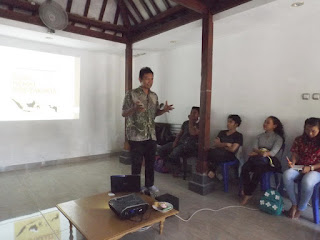 Two dozens of participants joined the three sessions discussion. The first session was guided by Trustha Rembaka, which invited participants to review the early history of Christianity. Participants read the Bible of the apostles who received a mandate from Jesus Christ to preach the gospel to every person, started from Jerusalem, Judea and Samaria to the ends of the earth as recorded in Acts 1:8. While the term Christian itself appeared around the year 40 AD. Early Christianity started from Palestine then spread to various cities in Asia Minor, North Africa and Syria. Although there were challenges and obstacles, Christianity continued to grow up to Greece to Rome. Roman Empire at the time had very strong influence. Some emperors were opposed to Christianity, but there were some who eventually became a Christian.
Two dozens of participants joined the three sessions discussion. The first session was guided by Trustha Rembaka, which invited participants to review the early history of Christianity. Participants read the Bible of the apostles who received a mandate from Jesus Christ to preach the gospel to every person, started from Jerusalem, Judea and Samaria to the ends of the earth as recorded in Acts 1:8. While the term Christian itself appeared around the year 40 AD. Early Christianity started from Palestine then spread to various cities in Asia Minor, North Africa and Syria. Although there were challenges and obstacles, Christianity continued to grow up to Greece to Rome. Roman Empire at the time had very strong influence. Some emperors were opposed to Christianity, but there were some who eventually became a Christian. The second session was hosted by Yohanes Dian Alpasa. He explained that Christianity has had power and became the state religion. Its great power finally pushed to fraud committed by rogue elements of church leaders that people who have difficulty unnoticed even ignored by the church, bribery among officials of the church for a certain position, infidelity and sex scandals among church leaders, the sale of indulgence letters, as well as sacred objects and cult without clear meaning. Martin Luther initiated campaigning reformation of the church in 1517. Reformation appeared to improve the church so that the church's existence was able to bring people into a better life. Church reform movement spread to many countries in Europe such as Switzerland, Germany, Holland, France and England. The development of Christianity in many different areas generated churches and agencies with specific characteristics and uniqueness, although the essence of Christianity has no difference.
The second session was hosted by Yohanes Dian Alpasa. He explained that Christianity has had power and became the state religion. Its great power finally pushed to fraud committed by rogue elements of church leaders that people who have difficulty unnoticed even ignored by the church, bribery among officials of the church for a certain position, infidelity and sex scandals among church leaders, the sale of indulgence letters, as well as sacred objects and cult without clear meaning. Martin Luther initiated campaigning reformation of the church in 1517. Reformation appeared to improve the church so that the church's existence was able to bring people into a better life. Church reform movement spread to many countries in Europe such as Switzerland, Germany, Holland, France and England. The development of Christianity in many different areas generated churches and agencies with specific characteristics and uniqueness, although the essence of Christianity has no difference.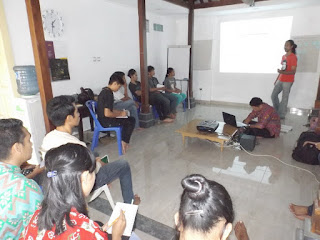 The history of Christianity in Indonesia was presented by Vicky Tri Samekto in the third session. He explained the background of the Europeans who venture into various corners of the earth, known as 3G, namely Glory, Gold and Gospel. In 16th century Christianity began to enter Indonesia, particularly in eastern Indonesia such as Ternate, Maluku, Nusa Tenggara and Timor. Roman Catholicism was brought by the Portuguese and Spanish, while the flow of Protestant Christianity was brought by the Dutch.
The history of Christianity in Indonesia was presented by Vicky Tri Samekto in the third session. He explained the background of the Europeans who venture into various corners of the earth, known as 3G, namely Glory, Gold and Gospel. In 16th century Christianity began to enter Indonesia, particularly in eastern Indonesia such as Ternate, Maluku, Nusa Tenggara and Timor. Roman Catholicism was brought by the Portuguese and Spanish, while the flow of Protestant Christianity was brought by the Dutch.by adminstube
 There were two different places and time to celebrate Christmas. The first celebration was held in Dreamhouse foundation on December 12, 2016. The foundation took care for children who are school dropout, having no place to stay. Celebrating Christmas with children in Dreamhouse has a hope that the students can share love and care for them. The second celebration was held at campus of ITY and served in form of Catholic liturgy, led by father Januarius Berek.
There were two different places and time to celebrate Christmas. The first celebration was held in Dreamhouse foundation on December 12, 2016. The foundation took care for children who are school dropout, having no place to stay. Celebrating Christmas with children in Dreamhouse has a hope that the students can share love and care for them. The second celebration was held at campus of ITY and served in form of Catholic liturgy, led by father Januarius Berek.
In the end of the celebration, Stube-HEMAT asked Deltiar, the chairman of the committee, about his hope. "I expect the Christmas celebration go well, the peace of Christmas be with us and the student fellowship will be getting better in the future. The celebration would not be possible without the cooperation of all members of the student fellowship and assistance from the seniors." Meanwhile Stube-HEMAT as a forum for students hoped that students have time to actualize themselves through training program held by Stube-HEMAT. (ITM).
by adminstube
Web Archive
2024 (6)Total: 449







